Recently, carbon dioxide monitors have been gaining a lot of attention. With findings showing how detrimental CO2 is to our cognitive performance and drowsiness levels, it’s no wonder that more people are interested in monitoring the carbon dioxide concentrations in their local environment.
However, it was only the more recent finding that carbon dioxide concentrations act as a proxy for the risk of catching COVID-19 that carbon dioxide monitors began to take off. With no accurate way to determine the number of COVID-19 particles in the air, the ability to monitor carbon dioxide is the next best alternative – but more on that soon!
Due to these findings, carbon dioxide monitors have gained much popularity over the past couple of years. While schools and offices have been turning to wall-mounted and desk-based solutions, consumers have turned to portable carbon dioxide monitors. The first of these devices to gain widespread popularity was the Aranet4 Home. However, despite many competing monitors, the most well-known and reputable device has remained the Aranet4 Home.
The Aranet4 Home (which I will refer to as the Aranet4) is a hand-held carbon dioxide monitor about half the length of a small smartphone. Although about twice the thickness, the device is easily pocketable – even alongside a wallet and earbuds. On the front of the device is an e-ink screen featuring different environmental readings. Most notable is the large CO2 parts per million (PPM) reading dominating the screen’s centre.
All this is to say the Aranet4 is a simple device with one feature – to monitor carbon dioxide levels and quickly and effectively communicate them with the user. However, the technology behind the device is very complex, and there are only a few accurate carbon dioxide monitors on the market. The Aranet4 is one of the few accurate devices.
The team at Aranet was kind enough to send me an Aranet4 Home for review. Over the past year, I’ve used the device extensively. I’ve travelled with the monitor, taking it on planes, buses, and into malls. I’ve also used it at home and during walks in the park to test the accuracy of the readings against atmospheric air.
After using the device in various settings, I am happy to share my full review of the Aranet4. This review will examine the device’s accuracy, usability, and price. However, I first want to address the elephant in the room – is a CO2 monitor necessary, and who can use such a device?
Note: The Aranet4 comes in two variants – the Aranet4 Home and Aranet4 PRO. Both devices are the same in accuracy, design, and user experience. However, the critical difference is that the Aranet4 Home is designed to be used as a standalone device. Aranet4 PRO is designed to be part of a network including multiple Aranet4 PROs and an Aranet PRO Base Station. View the differences here.
If you are an individual user looking for a carbon dioxide monitor, the Aranet4 Home is the device for you. If you need to monitor multiple devices – such as in a school where you might have a monitor in every classroom, the Aranet4 PRO is more capable.
Subscribe to BreatheSafeAir
Learn about the best carbon dioxide monitors, get discounts, and more!
This post contains affiliate links. For more information, please refer to my affiliate disclaimer. I was sent a product for review, but the article is not sponsored. All opinions expressed in this post are my honest thoughts. I only recommend products that I genuinely believe in.
Information on this blog is for informational purposes only. Readers are encouraged to confirm the information herein with other sources. Furthermore, this information is not intended to replace medical advice from professionals. This website assumes no responsibility for the accuracy of the information, and information is subject to change without notice. Devices mentioned on this website are not medical devices and do not guarantee protection.
Aranet4 Home Video Review
Do I Need a Carbon Dioxide Monitor?
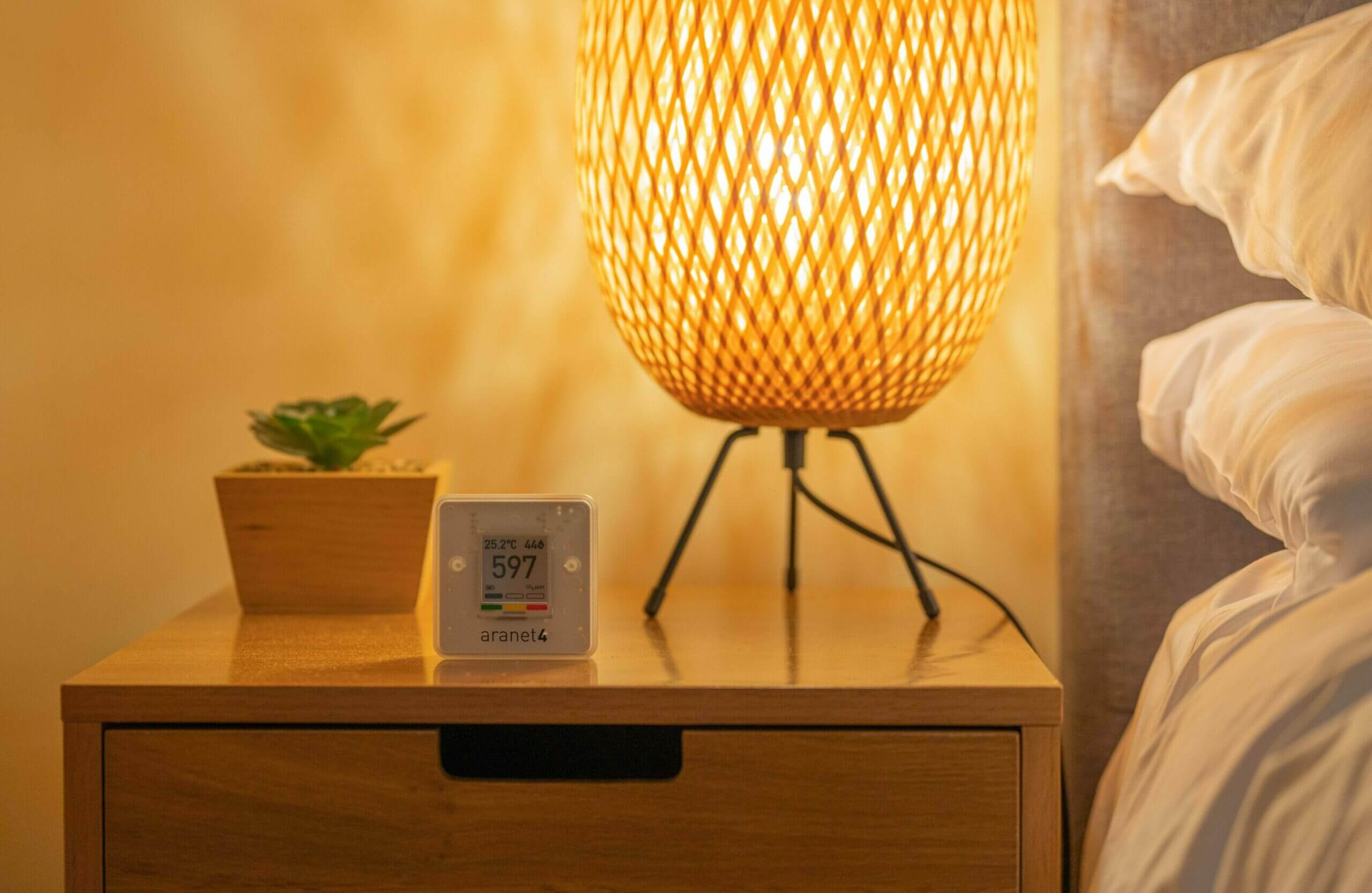
If you’re an air quality enthusiast and already know the importance of a carbon dioxide monitor, feel free to skip this section. However, I foresee many people asking this, so I want to address the topic before starting my review. At the end of the day, it’s not a very helpful review if we don’t discuss why a user might want the particular product to begin with!
Carbon dioxide is a prevalent gas, and it’s something that surrounds us. However, while we hear about the impacts of carbon dioxide in the atmosphere almost every week, we rarely hear about the microscale impacts of carbon dioxide. Considering we live in an atmosphere including carbon dioxide, surely it can’t harm us?
Well, yes and no. The concentrations of carbon dioxide we are usually exposed to are unlikely to cause long-term damage. For that to occur, we must be exposed to severe carbon dioxide concentrations for a long time.
However, carbon dioxide does significantly impact us in the short term. A Havard study found that at 1400ppm (parts per million), our cognitive function decreases by 50%. 1400ppm isn’t incredibly high, and this is a concentration you can regularly find in indoor areas, including schools, offices, and homes.
Excess carbon dioxide levels can also cause drowsiness, headaches, and many other issues – none conducive to good health. Since we tend not to consider carbon dioxide levels, we rarely consider how they can impact us – however, they can affect us significantly.
While carbon dioxide alone alters how we think, it wasn’t until the COVID-19 pandemic that carbon dioxide monitors began to take off. This is because while we currently have no device to monitor the airborne COVID-19 particles in a given area, we can monitor the carbon dioxide.
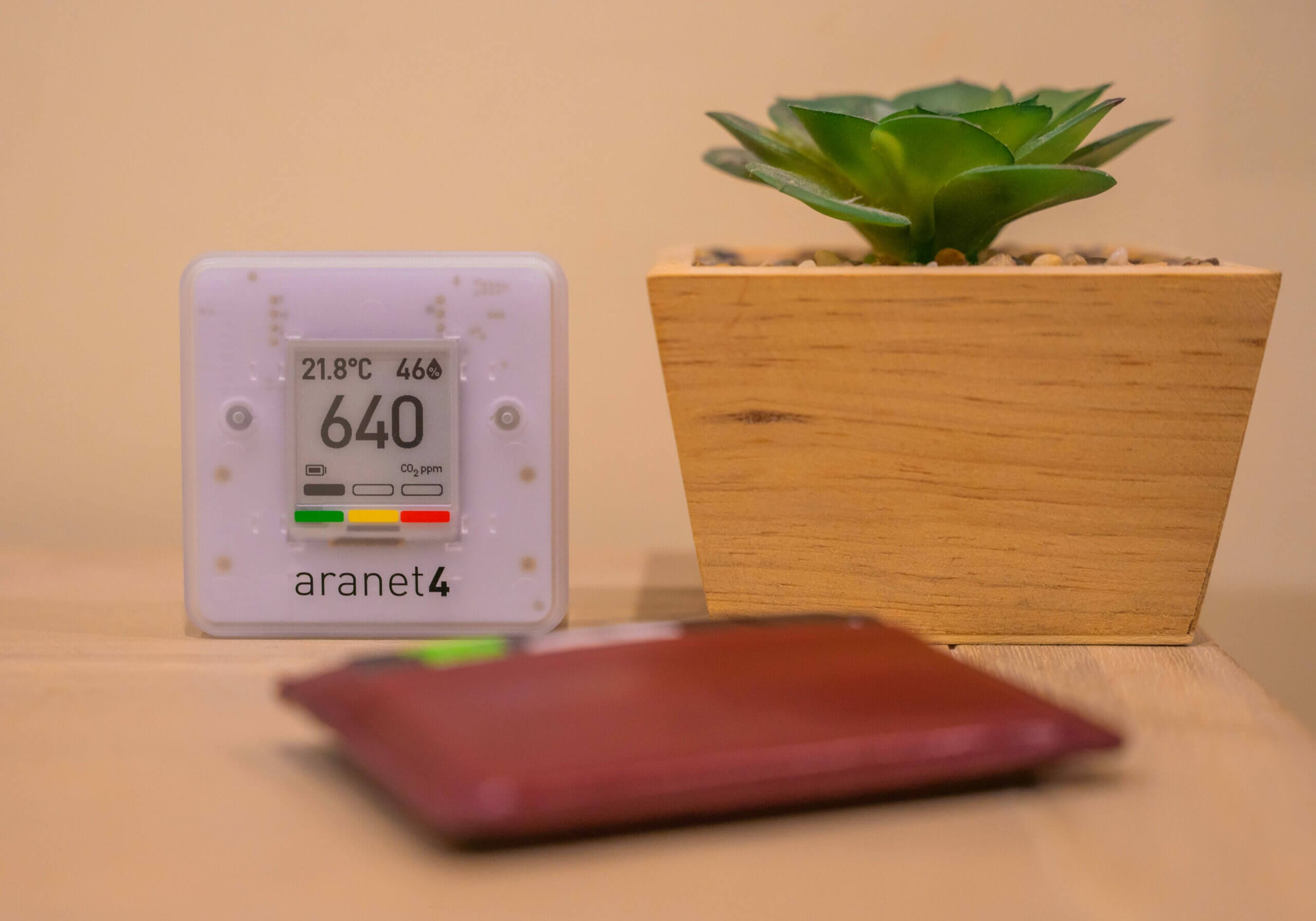
Carbon dioxide concentrations act as a proxy for the risk of COVID-19 transmission. Assuming you are in a shared space, a doubling in carbon dioxide concentration indicates twice the chance of contracting COVID-19. For example, on a bus with 800 ppm, you have twice the chance of catching COVID-19 compared to ambient levels (typically just over 400 ppm).
Of course, there are caveats to this. Firstly, you need to be in a shared space – no matter how high the carbon dioxide concentration, there is no airborne illness transmission risk if you’re in a room alone. Furthermore, the carbon dioxide concentration only reflects the COVID transmission risk if someone with the illness is present. For this reason, it’s an imperfect way to monitor the airborne illness risk, but it is the best method we have and having a device such as the Aranet4 Home can allow us to judge risk in any given environment.
This proxy risk caused a massive boom in the popularity of handheld carbon dioxide monitors such as the Aranet4 Home. However, it’s far from the only reason to have a carbon dioxide monitor, as the gas has a range of adverse health impacts that are important to avoid.
A carbon dioxide monitor will allow you to see into a world you otherwise can’t. It will let you know when this invisible gas changes how you feel and when better ventilation is needed. Even further, if you want to use it as a portable device, it will let you understand the COVID-19 (and other airborne viruses) risk at any moment.
Carbon dioxide monitors are a relatively niche device; not everyone needs one. However, I’ve found it incredibly useful after using the device daily for over a year. Not only have I learnt where high-risk areas are and where I should be donning my mask (for COVID-19 and other airborne illnesses), but I’ve also learnt what rooms in my house need more ventilation and have been able to improve their air quality.
As a final note, I had a friend who lived in a small apartment and complained about constantly feeling tired at home. I mentioned it could be carbon dioxide and recommended he open the windows regularly to see if it would help. A few days later, he returned to me and said it was life-changing – he felt far fresher and more awake than he had at home in months.
Monitoring carbon dioxide levels and acting on the information is incredibly beneficial. Like indoor air pollution monitors, which monitor the particulate matter and VOCs, I recommend a portable device such as the Aranet4 Home for anyone wanting to improve the quality of the air they breathe. It really can change how you live and especially how you feel.
Accuracy
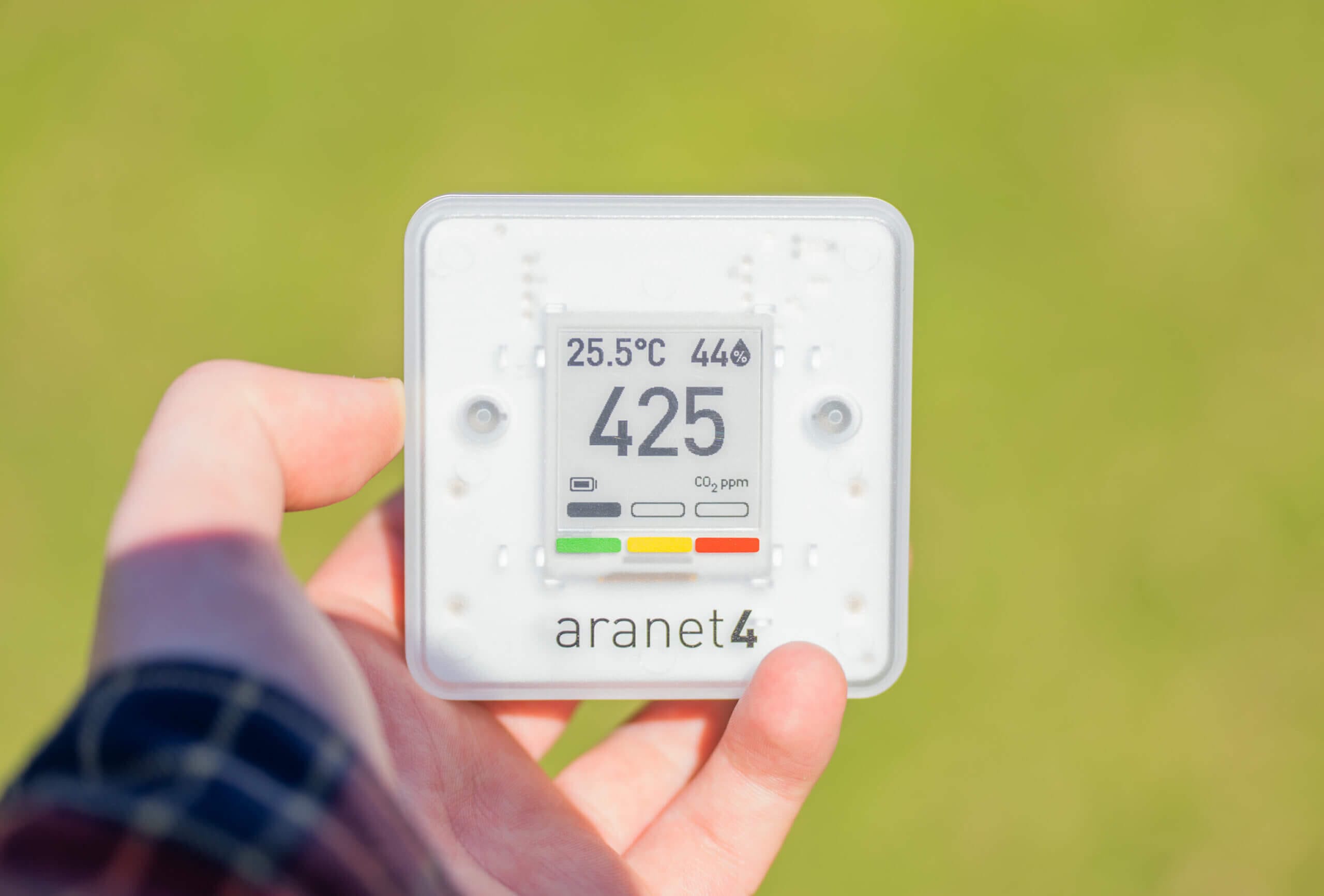
Perhaps the most critical question regarding CO2 monitors is ‘What is the accuracy?’. Accuracy is the most significant difference between cheap and pricier alternatives within this space – it’s also what drives the price of the Aranet4 Home up. However, it’s also essential to have an accurate device – not only are you not getting accurate information with some cheaper alternatives, but you could be being misled entirely.
When it comes to CO2 monitors, NDIR sensors are the gold standard. NDIR stands for nondispersive infrared. These sensors shine light through an air-filled tube inside the device, and a sensor on the other end of the tube measures how much IR light reaches the sensor. The difference in light emitted by the lamp and that which reaches the optical sensor on the other end of the tube indicates how much light is absorbed by CO2 and, therefore, how high the CO2 concentration is.
Although cheaper monitors may use different types of sensors, none of these is as accurate as an NDIR sensor – many aren’t accurate at all. Most other sensors are electrochemical and are known to be less accurate. Unfortunately, some manufacturers have begun to label their devices as NDIR when they are not. This has caused a lot of mistrust within the space.
Aranet4 uses a genuine NDIR sensor, which largely constitutes the product’s high price. In Wirecutter’s words, the NDIR sensor in the Aranet4 is the most accurate you will find outside of laboratory-grade equipment. It’s an exceptionally precise sensor, and there are limited other affordable devices with the same accuracy. If you’re curious about other NDIR devices, please check out this article on the best carbon dioxide monitors.
Of course, even within NDIR sensors, there are differences between accuracy and performance. Aranet4 Home uses a high-performance NDIR sensor from Senseair, a company with extensive experience with air quality sensors. Senseair notes that the Aranet4 Home uses its Sunrise sensor.

This sensor has a CO2 ppm accuracy of ±30 ppm or ±3% of reading. This is the same accuracy as mentioned on Aranet’s spec sheet. This puts it among the market’s most accurate carbon dioxide monitors, as this is the best accuracy specification seen on a consumer-grade monitor. While there are other monitors with a stated accuracy of ±30 ppm or ±3% of reading, nothing I’ve come across is more accurate.
For most cases, the slight variation of ±30 ppm or ±3% of the reading (whichever is higher) is irrelevant. These monitors help give us insight into the actions we need to take regarding our indoor air quality – actions that don’t differ if our concentration is 4000 or 4120ppm (+3%). Both readings indicate that ventilation is needed, and our actions should hardly differ from the 120ppm difference that may be witnessed on the Aranet4.
The Senseair Sunrise sensor is a single sensor – the humidity, temperature, and atmospheric pressure sensors included in Aranet4 are separate from the CO2 sensor. This is a different approach from sensors such as those offered by Sensirion, which includes all three sensors on the same chip.
Aranet lists a ±0.3 degrees Celsius or ±0.5 degrees Fahrenheit margin of error for the temperature sensor. This means the sensor can accurately identify the air temperature in a given location, allowing users to act on temperature readings to maintain ideal indoor air quality conditions.
The relative humidity sensor used within the Aranet4 Home is similarly accurate, having only a ±3% fluctuation in accuracy. Finally, the atmospheric pressure sensor has an accuracy of – 2 hPa and + 3 hPa. All sensors in the device have minimal drift, and the device will be accurate even after years of use.
Overall, the Aranet4 Home (and PRO) are very accurate devices and among the most precise on the market. Especially compared to cheaper NDIR-equipped products, the Aranet is more accurate and will provide accurate readings for many years.
Calibration
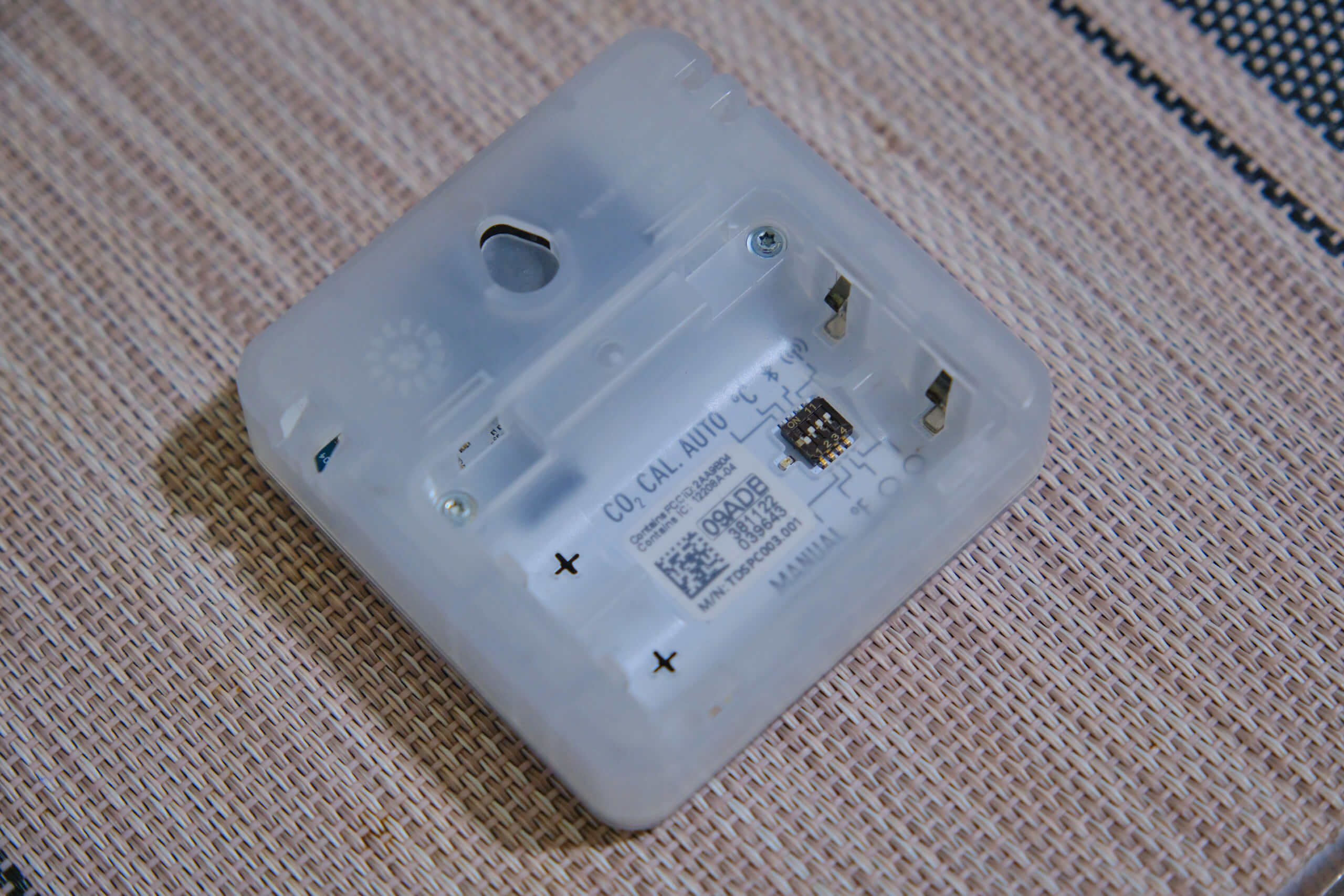
You can swap between automatic and manual calibration on the back of the device.
No matter how high-end the sensor, carbon dioxide monitors must be recalibrated occasionally. The Aranet4 uses a single-beam NDIR sensor, meaning while it is very accurate, it has no baseline value which it can use to recalibrate itself. Some other carbon dioxide monitors, such as the CO2.Click Model C use dual-beam NDIR sensors that are less prone to drift over time.
Luckily, this isn’t an issue for two reasons. Firstly, the Aranet4 can be both manually and automatically recalibrated easily. Secondly, the Sunrise sensor in the device is known for holding its accuracy incredibly well, and some users have reported being able to go a year before seeing a noticeable drift in their carbon dioxide readings.
Of course, the time will come when you need to recalibrate your Aranet4 Home. To do this, you will want to take your device outside (somewhere with a carbon dioxide concentration as close to 420 ppm as possible) and leave your device alone for about 30 minutes. You will then want to walk a few metres away (so your breath doesn’t interfere with the ambient levels) and press ‘start calibration’ on the app.
This process will take about half an hour, allowing the Aranet4 Home to take a new baseline reading. From now on, the device will use that calibrated concentration as its baseline, and all future readings will be taken, assuming that 420 ppm reading is accurate. It is worth mentioning that once you calibrate the device, you can never return it to factory calibration.
The Aranet4 Home also has automatic calibration. This allows the device to calibrate itself automatically every 30 days and can be switched on and off via a small switch located under the double A batteries used to power the device. While this might sound like a handy feature, I recommend caution regarding automatic calibration on any carbon dioxide monitor.
While automatic calibration can be handy if you take your device outside for at least eight hours every month, it can quickly lead to inaccurate readings if this isn’t the case. Automatic calibration works by taking the lowest recorded carbon dioxide concentration over a set period (in this case, 30 days) and setting that as the new baseline, 420 ppm. This can become an issue if the device is never exposed to outdoor air. Before you know it, your Aranet could think 1000 ppm is 420 ppm!
For this reason, automatic calibration should only be used if you regularly take the device outside. Aranet Tech Support suggests the minimum should be eight hours every month, which doesn’t need to be done simultaneously. As long as the cumulative time the Aranet4 spends exposed to outdoor air is eight hours monthly, automatic calibration should be reliable.
Of course, if the readings ever seem suspicious to you, a manual calibration is in order. Unfortunately, there is no easy way to judge when calibration is needed, and you’ll need to decide this yourself. In my case, I recalibrate my Aranet4 every two to three months.
Real-World Use
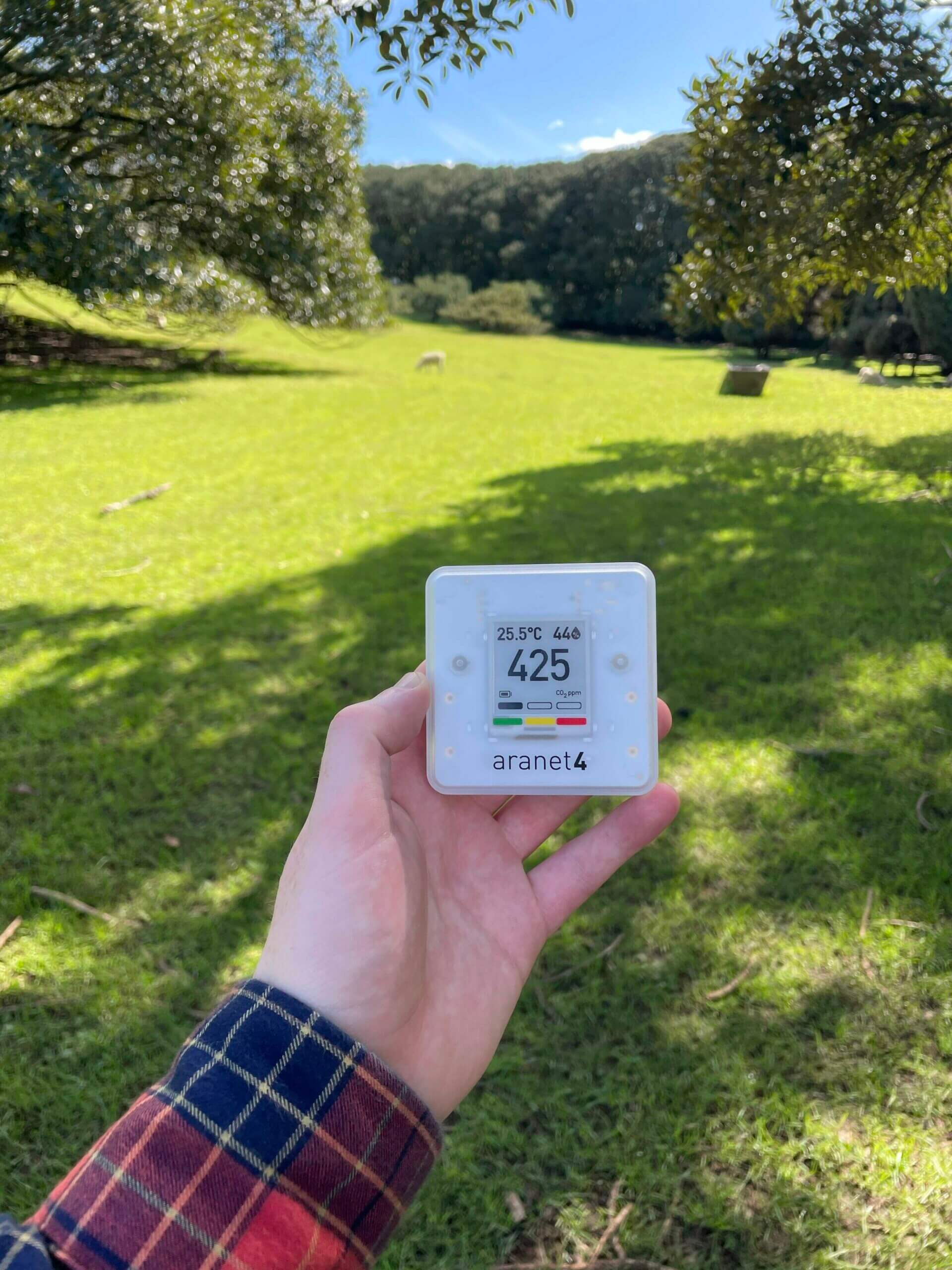
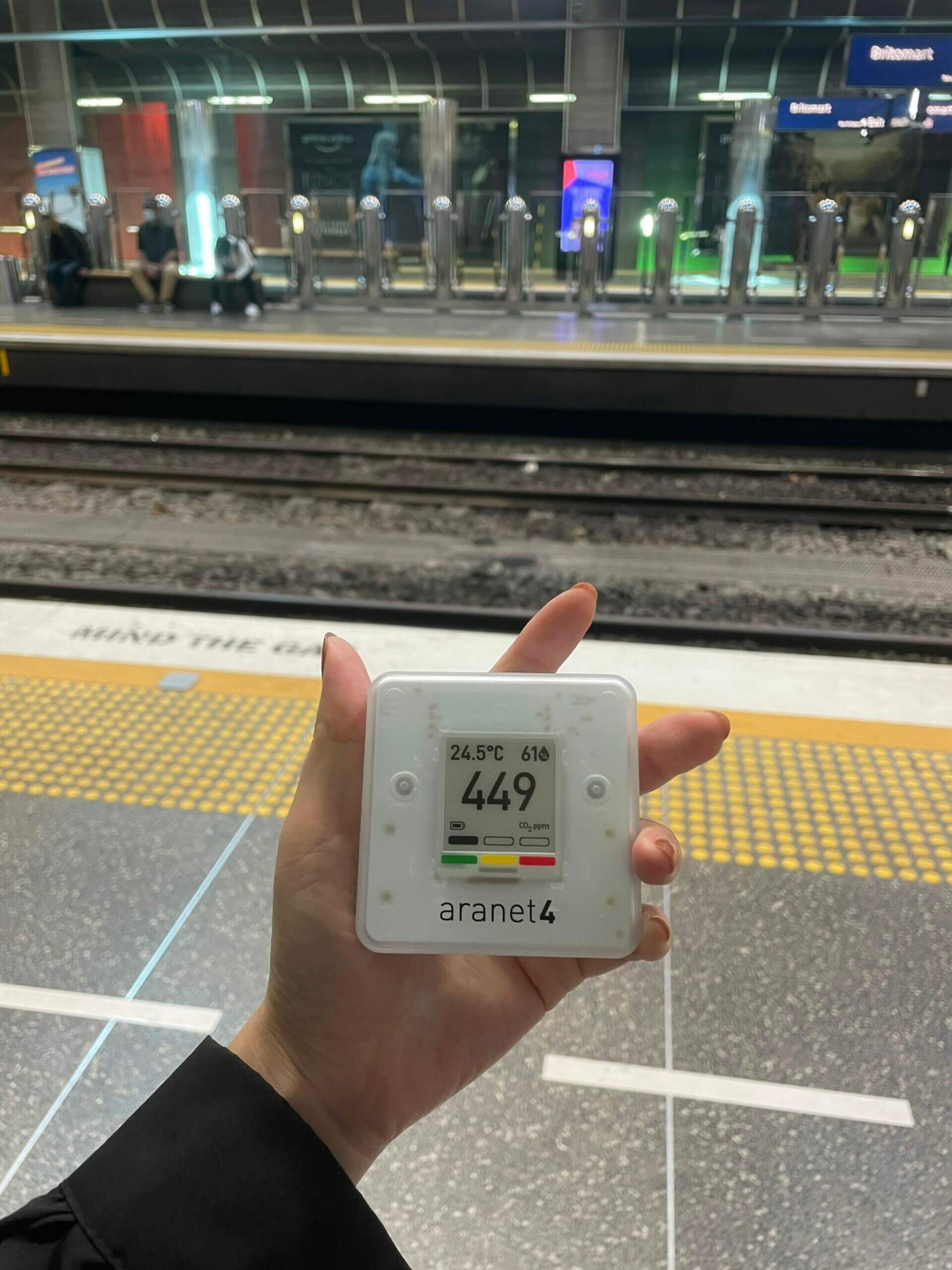
From left: outdoor (ambient) CO2 reading. Underground train station CO2 reading.
Perhaps the best way to display the capabilities of the Aranet4 Home is to show the device in use. As mentioned earlier, I’ve taken the device into various settings over the past year and had some fascinating findings. Let’s dive into some of them!
The first two images, shown above, were taken in an outdoor park in Auckland – the biggest city in New Zealand – and an underground train station. I wanted to share the first image because it shows Aranet’s reading in a near-ambient setting. As of 2021, the average atmospheric carbon dioxide concentration was just under 415 ppm. Since then, it’s increased slightly and now likely sits around 417ppm. However, this varies depending on location and the diurnal cycle, and you can view local carbon dioxide concentrations here.
Aranet showed CO2 in the range of 420-426ppm for three readings in a row. This is incredibly accurate, and while I’m not sure what the actual ambient concentration was then, it is very promising. This is exactly the concentration you would expect to see in an ambient environment.
The second image surprised me as I expected an underground train station to have a higher CO2 reading. I was pleasantly surprised! That said, the train station was relatively empty (as you can see), and there was a lot of ventilation from the surface. I would expect a very different reading in a train station in Seoul!
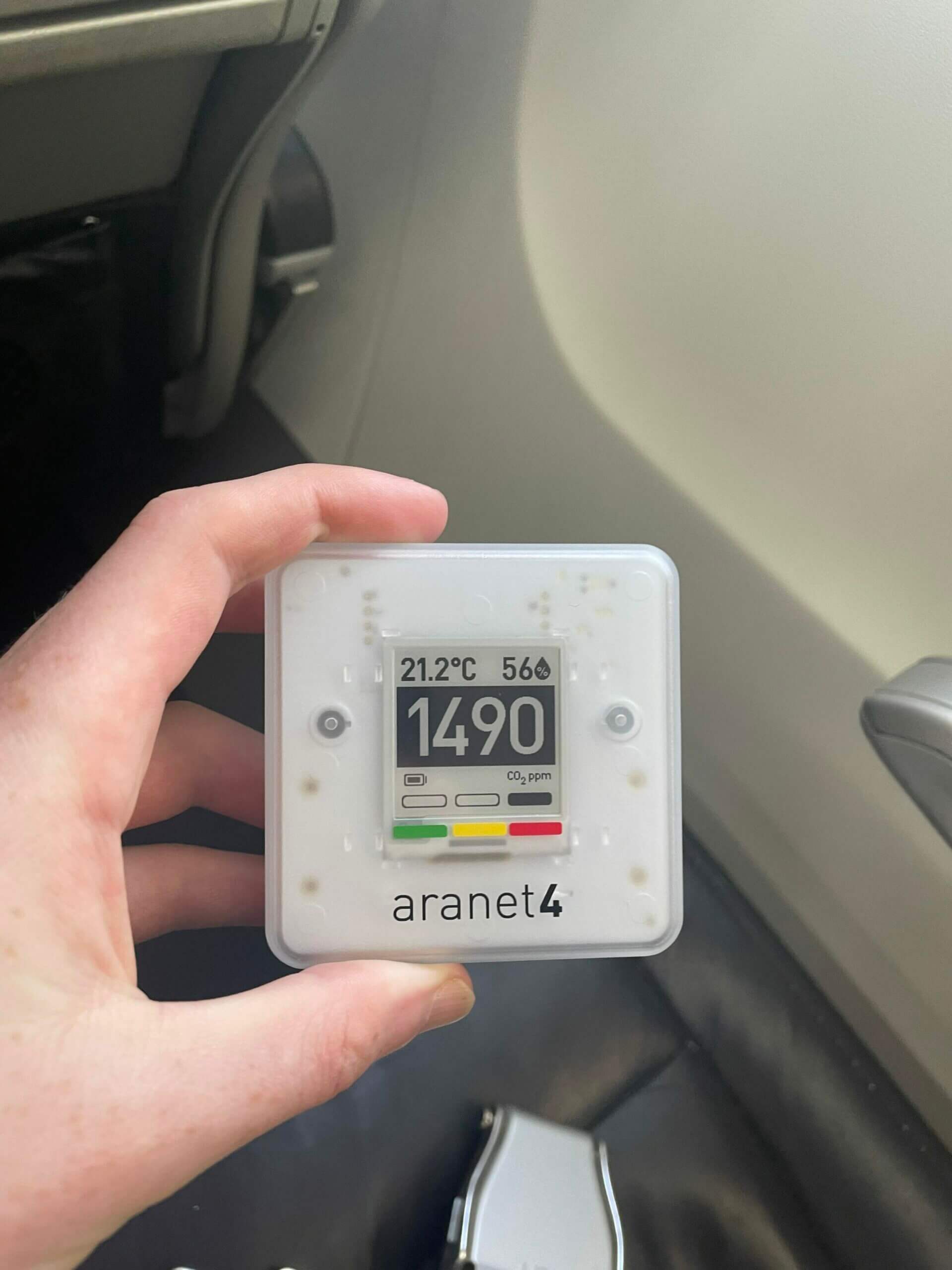
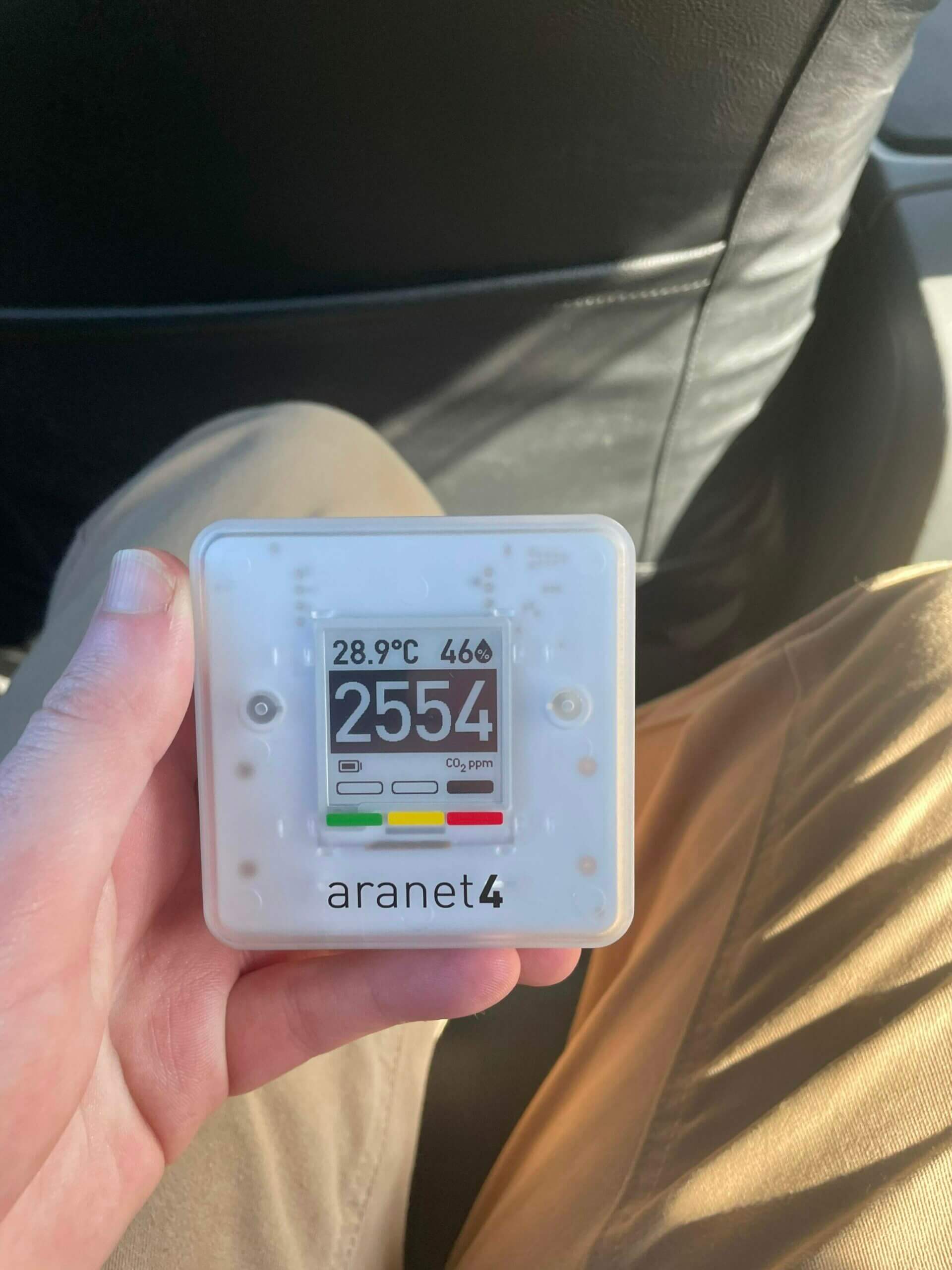
From left: CO2 measurement in a domestic flight (during take-off). CO2 measurement in a taxi.
These next couple of images are where things begin to become interesting! Both of them show high concentrations of CO2, which also indicates poor ventilation. In the case of the first image (taken during a full flight), the reading also indicates a 4x transmission chance of COVID-19 compared to ambient CO2 levels.
Although aeroplanes have ventilation and filtration systems, these don’t activate until the plane is airborne. This means that during boarding, taxiing, take-off and landing, CO2 levels can become exceedingly high. This issue is only exacerbated since planes often have many people on board.
The latter image shows an even worse reading. This one was taken during an Uber ride but can also apply directly to a taxi or other car-sharing service. Since the windows were up for the journey, carbon dioxide levels quickly increased – even with only three of us in the car. This reading was taken about 10 minutes into the journey, and we eventually saw the CO2 concentration reach 4100ppm later in the ride!
The COVID-19 implications in this situation are also interesting to consider. Given that there were only three of us in the car, the chances of one person having COVID-19 and being able to spread it are pretty low. However, had one person had COVID, the chances of the other two members catching it would be very high. Situations like this show the importance of wearing a mask in taxis, Uber, and other ride-sharing services.
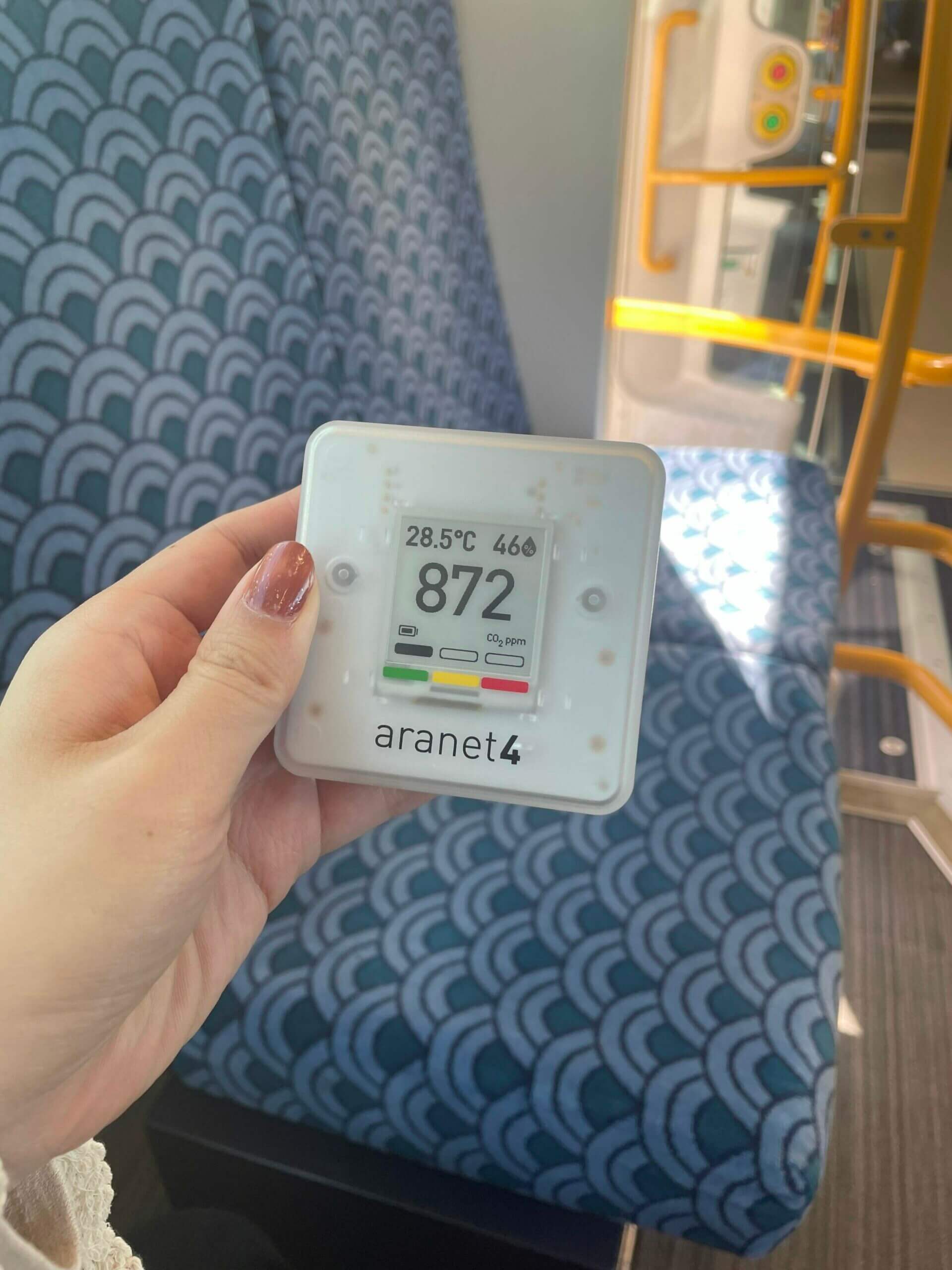
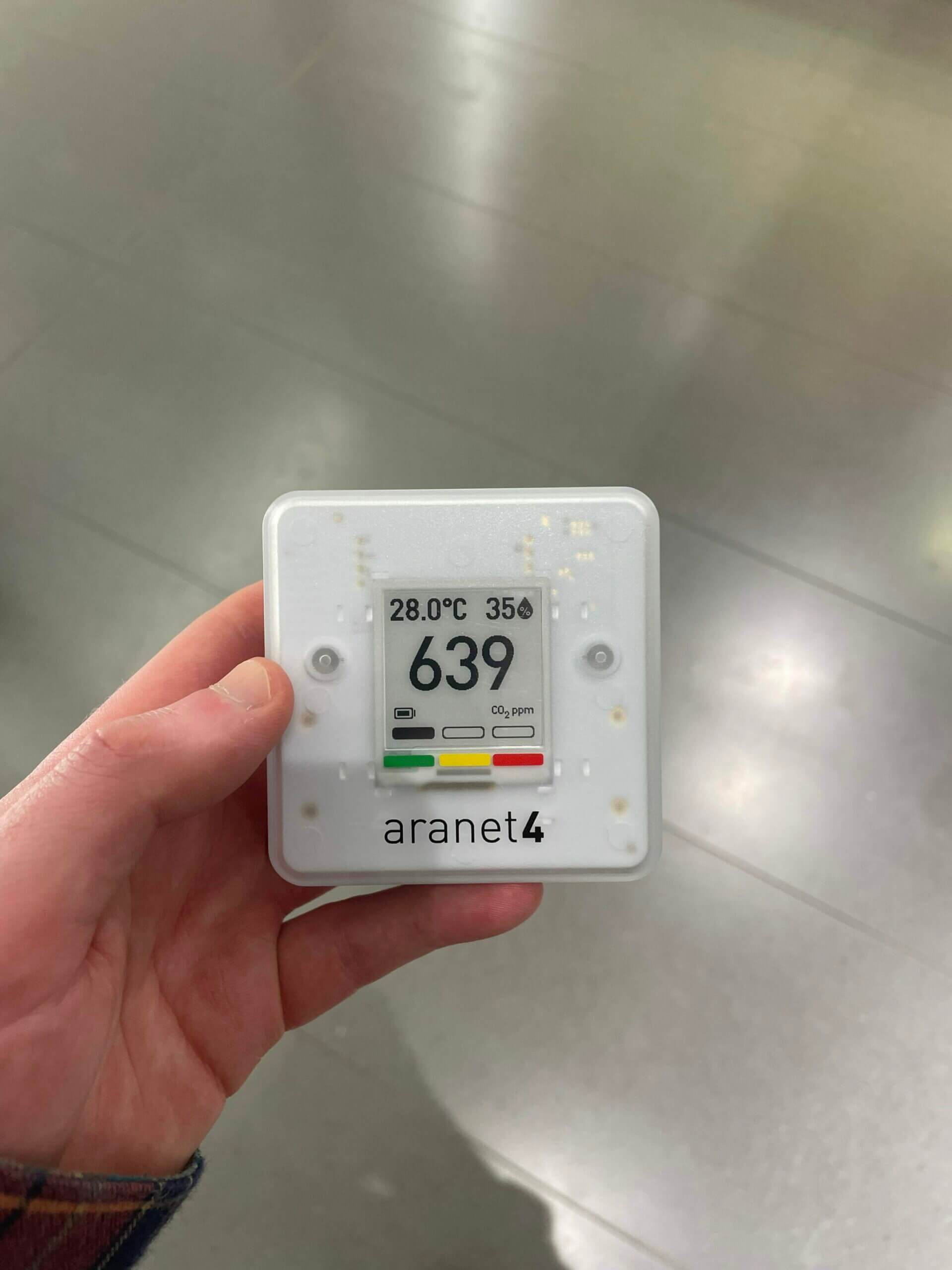
From left: CO2 reading in a public train. CO2 reading in a shopping mall.
The final two images I want to share in this section were taken on an (above-ground) train and in a shopping mall. In both situations, I was pleasantly surprised by the ventilation. I’ve seen many Twitter users sharing images of their Aranet’s reading as high as 4000ppm on public transport, and I was amazed to see how ‘great’ the readings on this train were.
With that said, this reading would vary significantly based on how crowded the carriages are. Further, the trains in Auckland are above-ground, meaning they get fresh air circulated through them at every stop. Regardless, I was impressed because even at peak hour, I only saw the carbon dioxide concentration peak at 1100ppm!
In the second image, I decided to take the Aranet4 Home into a shopping mall. The large shopping mall appeared well-ventilated, as readings never exceeded 800 ppm. Again, this excellent result shows that a well-ventilated shopping mall can manage carbon dioxide levels!
Overall, I had much fun taking the Aranet4 Home into various settings. More than that, I’ve learnt a lot. Having a carbon dioxide monitor has allowed me to glimpse a world I wouldn’t have otherwise known about. Or, at the very least, wouldn’t have been able to monitor.
App
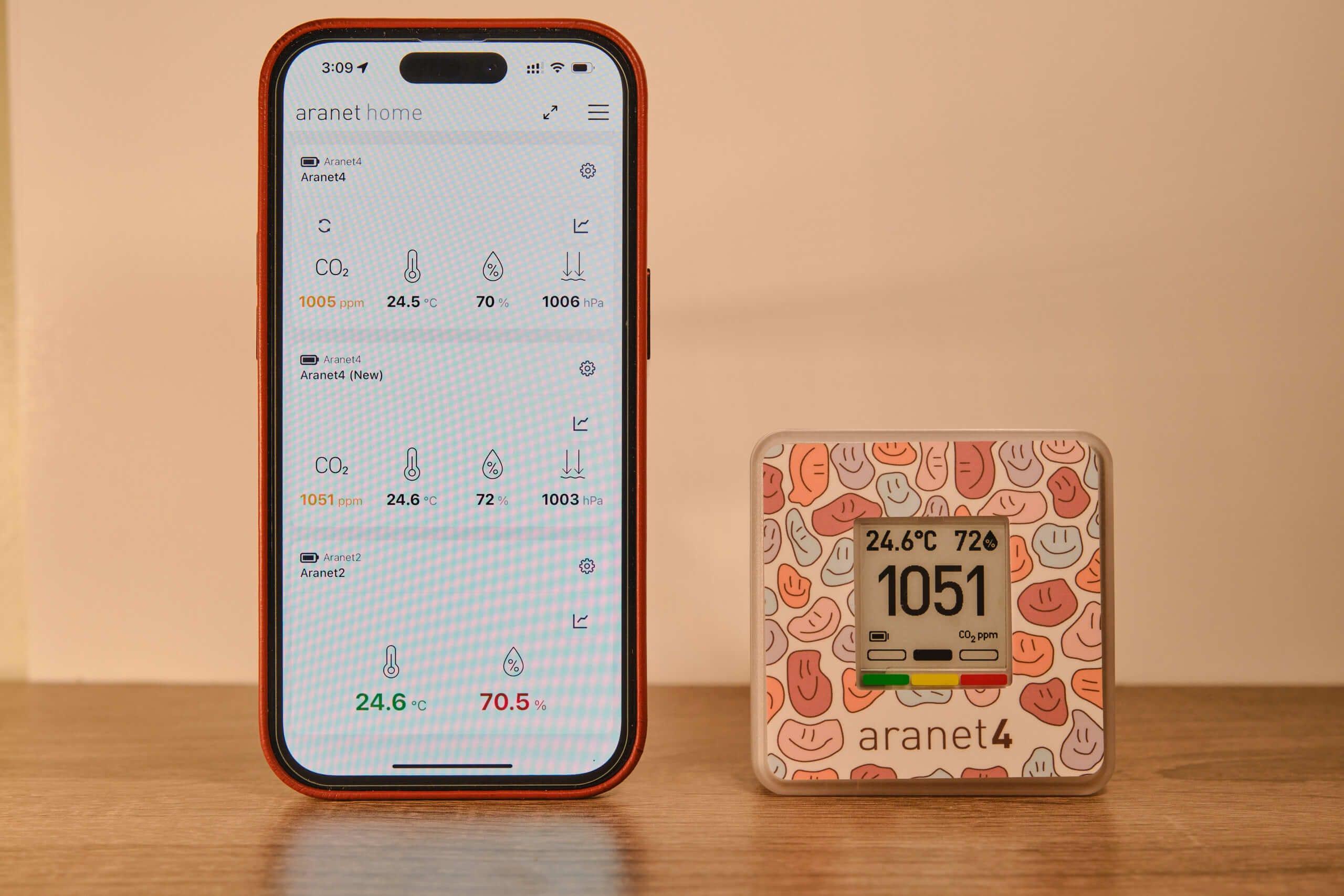
I used the Aranet iOS app on an iPhone 12 and iPhone 14 Pro. Experiences may differ on other operating systems/smartphones.
From my experience using air quality monitors, one of the most lacking areas is typically the app. Although some air quality monitors have decent apps, they all lack in some way, making them frustrating. Of all the apps I’ve tried, the best apps were from INKBIRD and Atmotube. However, even the Atmotube app is imperfect and could be vastly improved.
Aranet has created the first app in this field I would consider excellent (although the INKBIRD app has come out since, and I also consider it excellent). The app is fast and responsive, has never crashed on me, and provides data in a clear and easily readable form. Although some people may consider the app lacking or too simple, I think it’s perfect for the device.
The Aranet4 Home connects to your Android or iOS device via Bluetooth. While the Bluetooth range does not extend very far (I can’t use the app unless I am in the same room as the device), there is an option to extend the Bluetooth range in the app settings. However, I haven’t changed this setting as it decreases battery life.
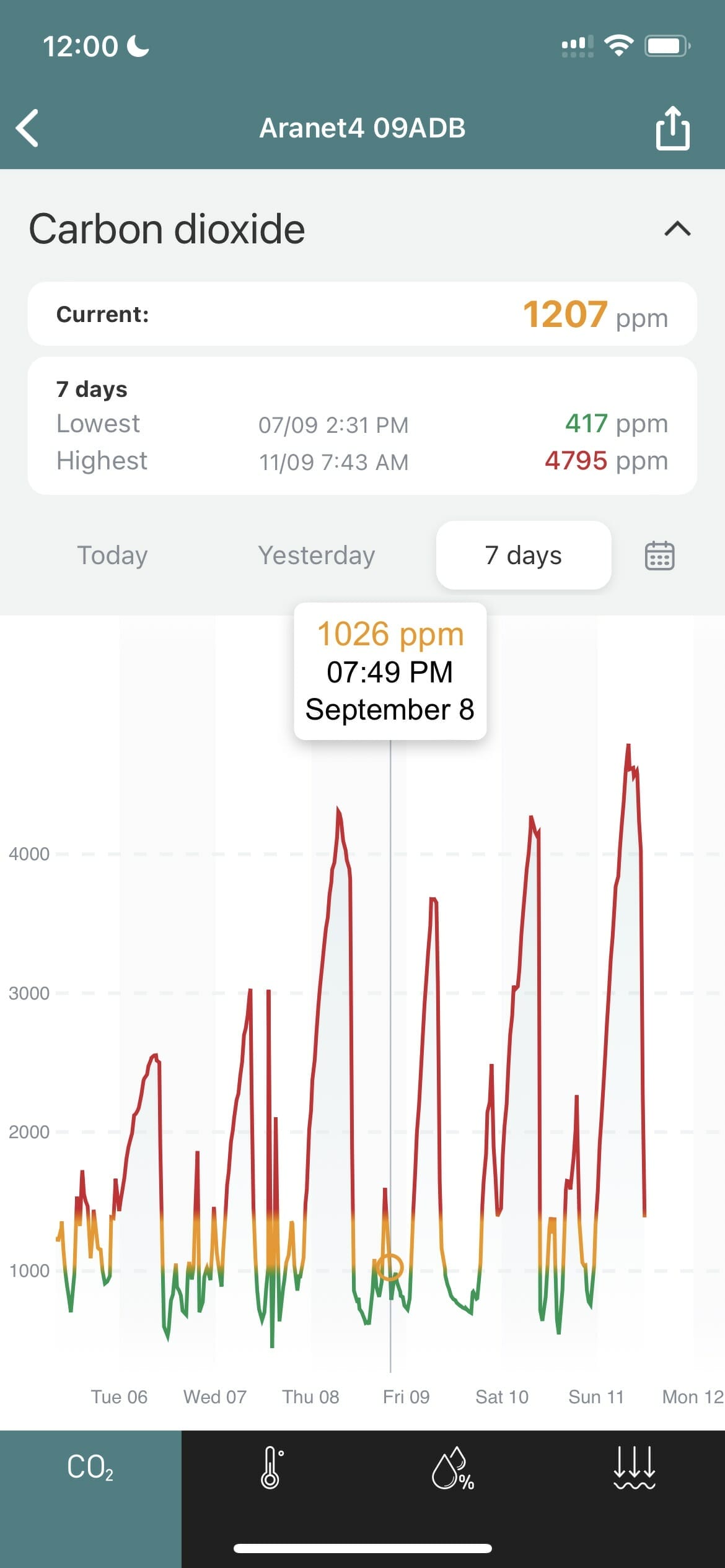
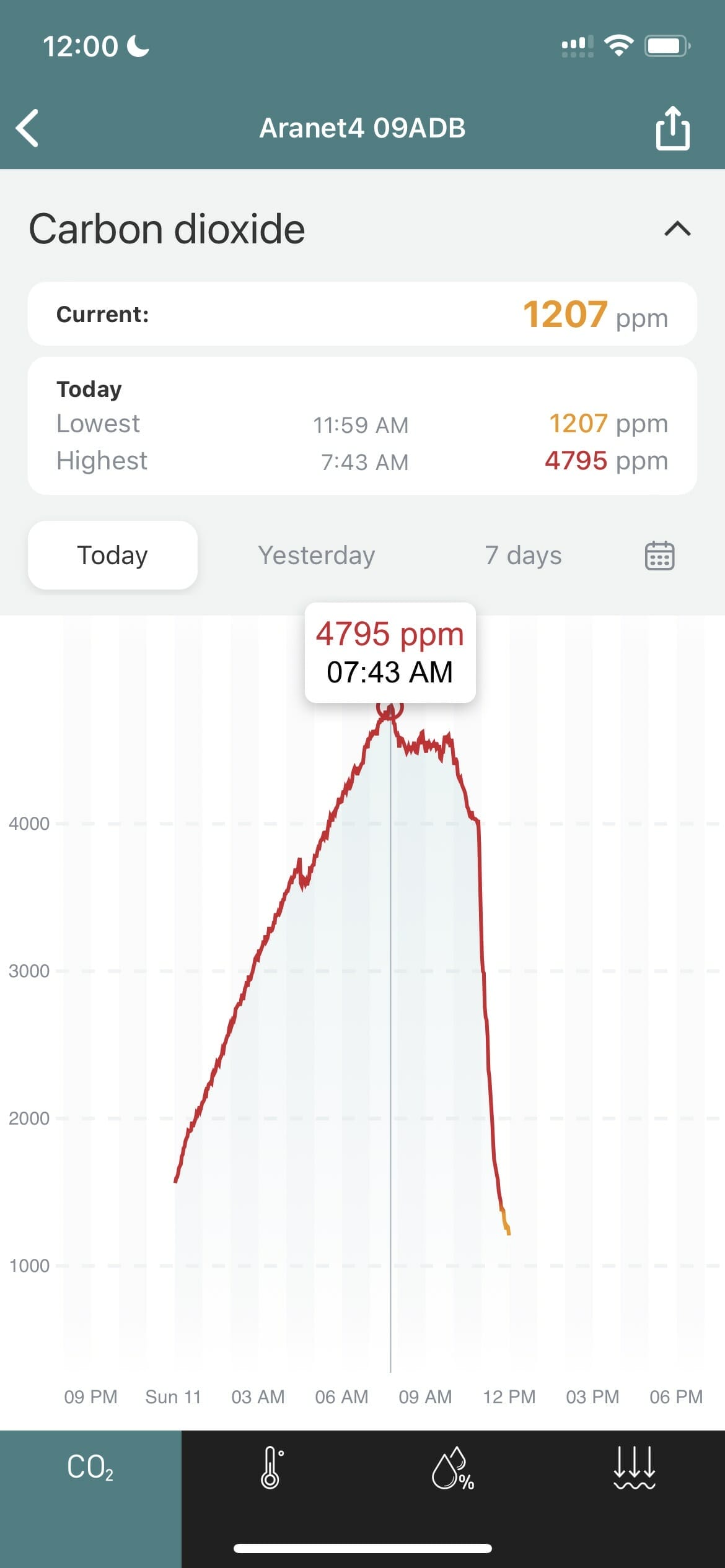
By default, Aranet4 Home will update itself once every five minutes. This is adjustable, and the user can specify if they want readings every one, two, five or 10 minutes. Again, it’s worth noting that an increase in measurement frequency will decrease battery life.
Through the app, the Aranet4 also has a very cool feature that was only released in 2023 – the ability to take an on-demand reading. This is incredibly handy and allows the user to force the device to update its reading. This process takes only a second, and it means you can set the device to take readings automatically every five or 10 minutes while force-updating when the situation calls for it. So far, this feature appears to be unique to the Aranet4.
Whenever you open the app on your phone, Aranet4 Home will send data to your smart device. This data will cover measurements the Aranet device has taken since you last opened the app. While I am not fond of this technique (since it can often be slow), it is a quick and painless process on this app. It is worth noting that if you don’t open the app frequently enough, you will lose data as there is limited memory on the device.
Once you’ve given the app a few seconds to update, you can see all carbon dioxide readings from the past 30 days. On top of this, humidity, atmospheric pressure and temperature readings will also be updated, giving the user a complete graph of the four readings. While 30 days is good, I can’t imagine this data takes much storage space, and I would love to see more data stored.
Analysing data on the app is straightforward. Scrolling through the graphs is very fast, and I never noticed any hiccups. You can view data for the day, yesterday, seven days, or a custom date (as selected on the calendar). However, data will only be stored for 30 days, so keep this limitation in mind.
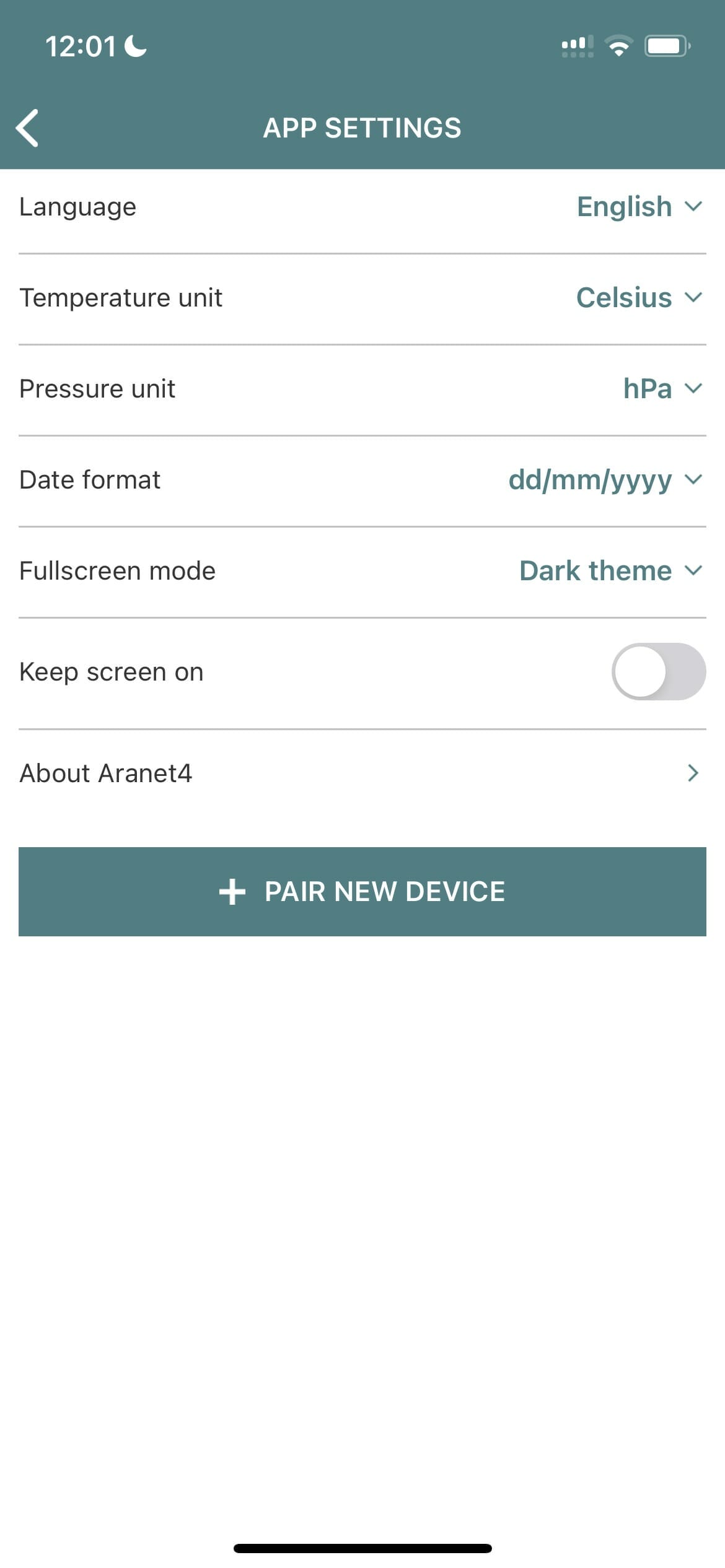
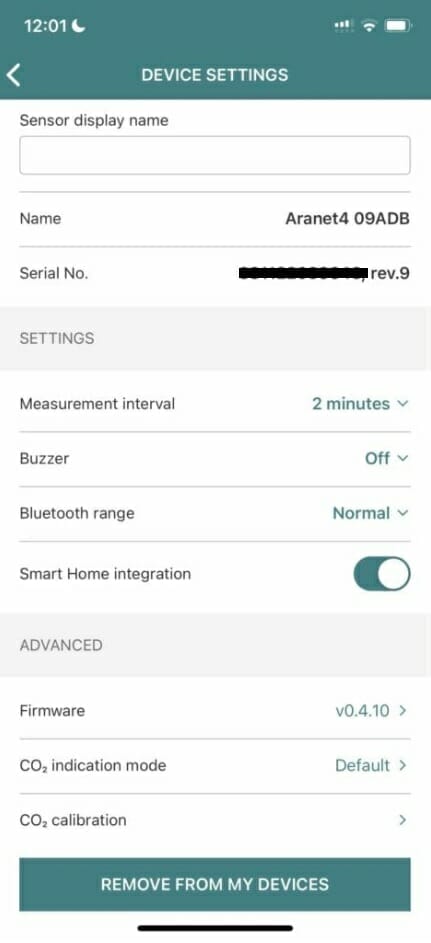
Users can adjust measurement intervals, buzzer sounds, Bluetooth range, CO2 indication mode (what colours indicate what concentration), and CO2 calibration in the app settings. Users can also toggle between temperature units, pressure units, and date formats to keep the device easily usable for everyone.
Overall, the app is fantastic. It’s not overly complex but still provides essential data in an easy-to-use format. I haven’t encountered a single crash or hiccup with the app, and it’s worked flawlessly thus far. It even allows users to export data (via the share menu) to be analysed on other programs and devices.
It’s also worth noting that there has been a substantial update in the year I’ve had the Aranet4 home, adding a few features to the device. This makes it clear that the team behind Aranet is invested in their device and ensuring it is the best it can be – unlike many other manufacturers who will happily leave their devices behind in favour of releasing a new one. While I don’t know if we will see future updates, I am confident that SAF Tehnika will keep supporting its device.
Price & Lifespan
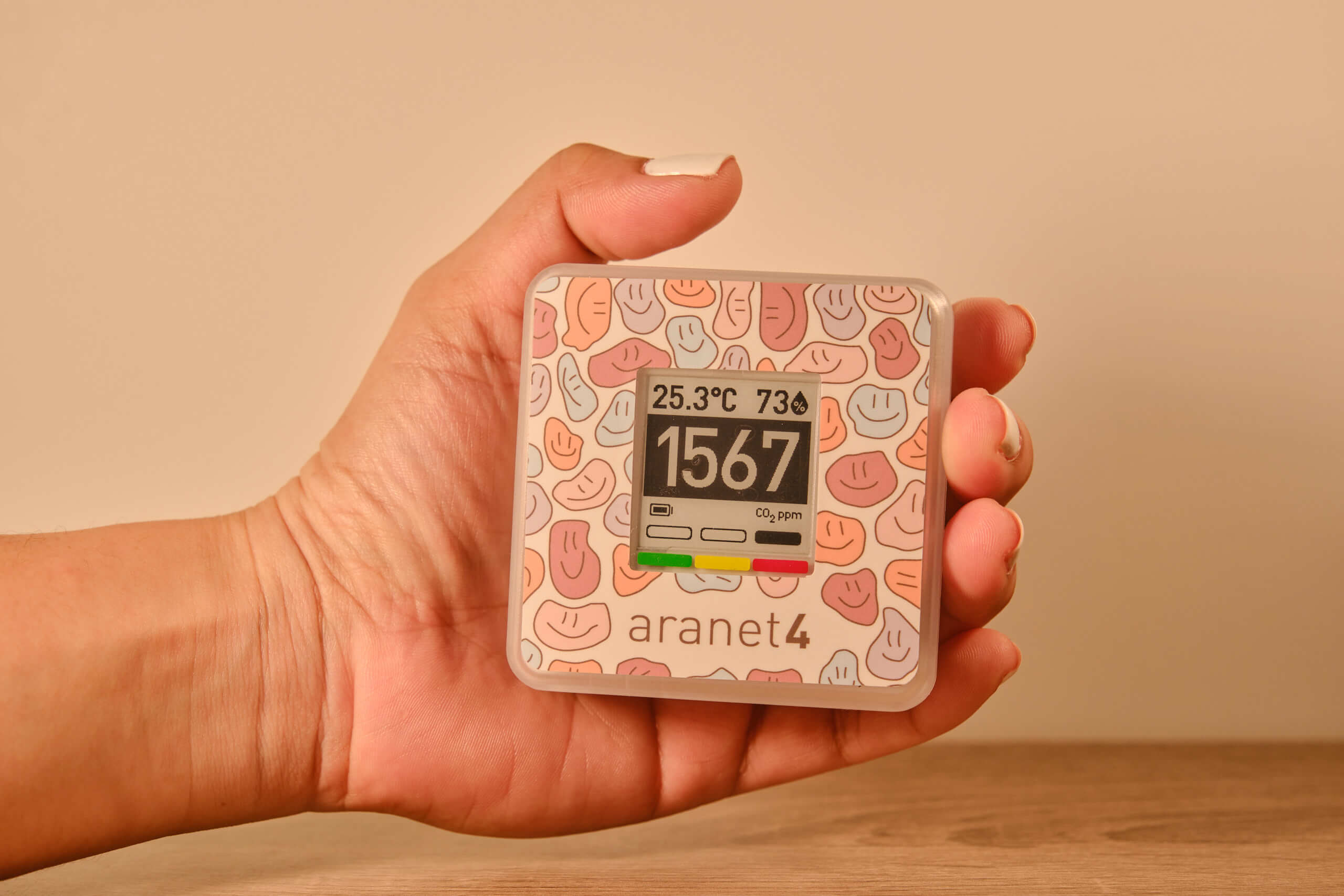
Before discussing pricing, I want to note that the Aranet4 Home price regularly changes. While it’s listed as 249 USD, it has recently been seen on Amazon for much cheaper. I’ve seen it as low as 169 USD before, and these days, it seems to be often less than $200. The 15% discount code ‘BREATHESAFEAIR’ also makes the device substantially cheaper than its listed price.
The Aranet4 Home is considered one of the best consumer-level carbon dioxide monitors. Due to this, the device has a premium price compared to many competing products. When writing, the Aranet4 Home is listed as 249 USD but is on sale for slightly under 200 USD. While this is an excellent price drop, it is still the most expensive consumer-grade carbon dioxide monitor.
This is far from cheap, and the pricing might seem very steep for a device that monitors only CO2. Unfortunately, this is one of the biggest issues with CO2 monitors – they have a steep barrier to entry regarding the price. While there are cheaper options, many will still cost you over 100 USD. With NDIR only recently entering the consumer market, prices for this technology are expensive and likely will be for a while to come.
That said, the Aranet4 Home is by far the most complete carbon dioxide monitor, and it is the gold standard for carbon dioxide monitoring. There are cheaper monitors, monitors with better connectivity, more portable monitors, and more; however, none feature the same complete package that the Aranet4 does. The closest monitor is the INKBIRD IAM-T1, but with recent price drops, that is a similar cost to the Aranet and lacks a few features the latter has.
Therefore, while 249 USD (and even 169 USD, which is the cheapest price I’ve seen) may seem steep (and it is), it isn’t unrealistic. Compared to the other air pollution monitors I’ve used, Aranet4 has the best smartphone integration via its app. It’s also incredibly easy to use, well-built, and highly accurate. Overall, this CO2 monitor provides a complete package.
| Device | Price | Accuracy |
|---|---|---|
| Aranet4 Home | $249 | ± 30 ppm OR ± 3% |
| Qingping Air Quality Monitor | $129 | ± 30 ppm OR ± 3%* |
| Qingping Air Monitor Lite | $100 | ± 70 ppm OR ± 3% |
| INKBIRD IAM-T1 | $169 | ± 30 ppm OR ± 3% |
| Vitalight Mini CO2 Detector | $49 | ± 50 ppm OR ± 3% |
| Temtop M2000 | $225 | ± 50 ppm OR ± 3% |
| Wohler CDL 210 | $219 | ± 50 ppm OR ± 3% |
As for the lifespan of the Aranet4 Home, provided the device is treated well and doesn’t get damaged, it should be able to provide accurate readings for many years. In addition, the CO2 sensor can be recalibrated and, therefore, suffers from no sensor drift. The Sunrise sensor is supposed to have a 15-year lifespan. While I doubt you will get 15 years out of an Aranet4, the device is made to last.
Some drift can be found over time in the temperature, humidity, and atmospheric pressure sensors. However, the drift is generally minimal and shouldn’t impact your device usage – even after five or more years.
Battery life is similarly incredible. While it varies based on the frequency of readings, the minimum battery life is around eight months. This is with updates every 1 minute, an option that most people won’t enable. However, if you lower the readout times to once every 4-minutes and use lithium batteries, the device can have a four-year lifespan!
If you pair the Aranet4 Home with some rechargeable double-A batteries, you have a device which can be recharged once per year and has no waste. This is how I’ve used the Aranet4, and I recommend it to anyone who doesn’t want to spend money on disposable batteries. Those lithium batteries quickly add up!
My biggest concern with the longevity of the Aranet4 Home is user damage. The device is not waterproof or water-resistant, so you must ensure you have a dry spot in your bag if you plan to take it out and about. Further, it’s not drop-resistant, and any significant drops could instantly break the device.
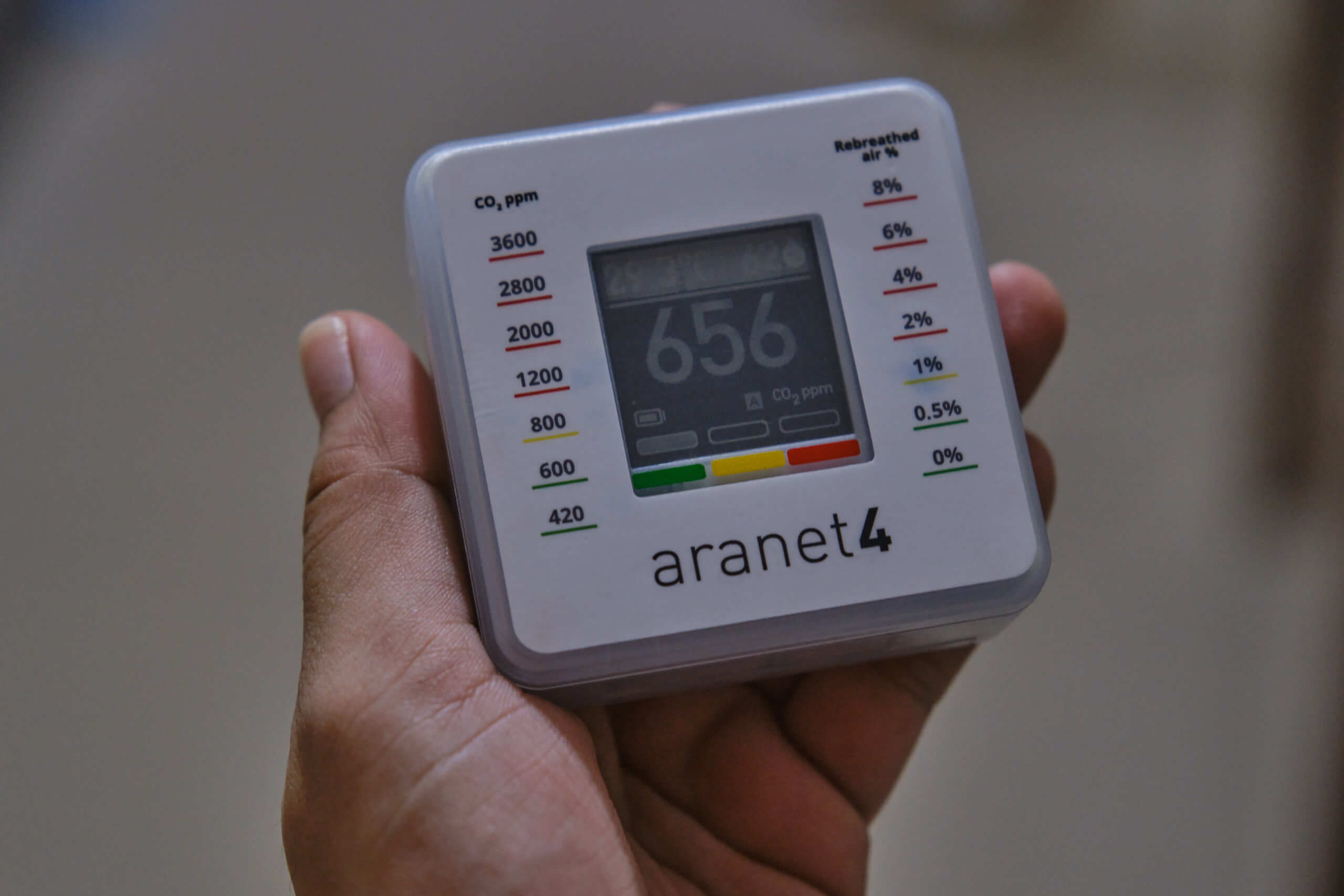
My first Aranet4, on which the screen stopped working.
This is where I should mention that I have broken an Aranet4 Home myself. When travelling, I placed my Aranet4 and Aranet2 monitors in a padded bag within my check-lugged. Perhaps it was a bad idea, but I thought they would be fine with bubble wrap and clothes around the monitors. Unfortunately not – my Aranet4 Home came out with a frozen screen that I cannot fix. While it can still be used via the app, the device screen is non-functional.
I’m assuming this damage was caused by rough handling of the suitcase, so I highly recommend a case for the Aranet4 if you plan to store it in a suitcase or bag regularly. Something like this little organisation pouch on Amazon works fantastically, and I use something similar I found at the store Miniso.
If you learn from my experiences and look after your Aranet4, it should have a fantastic lifespan and serve you well for many years. This lifespan, combined with the overall package of Aranet4, makes it a device I recommend – even at its steep price.
Customisation
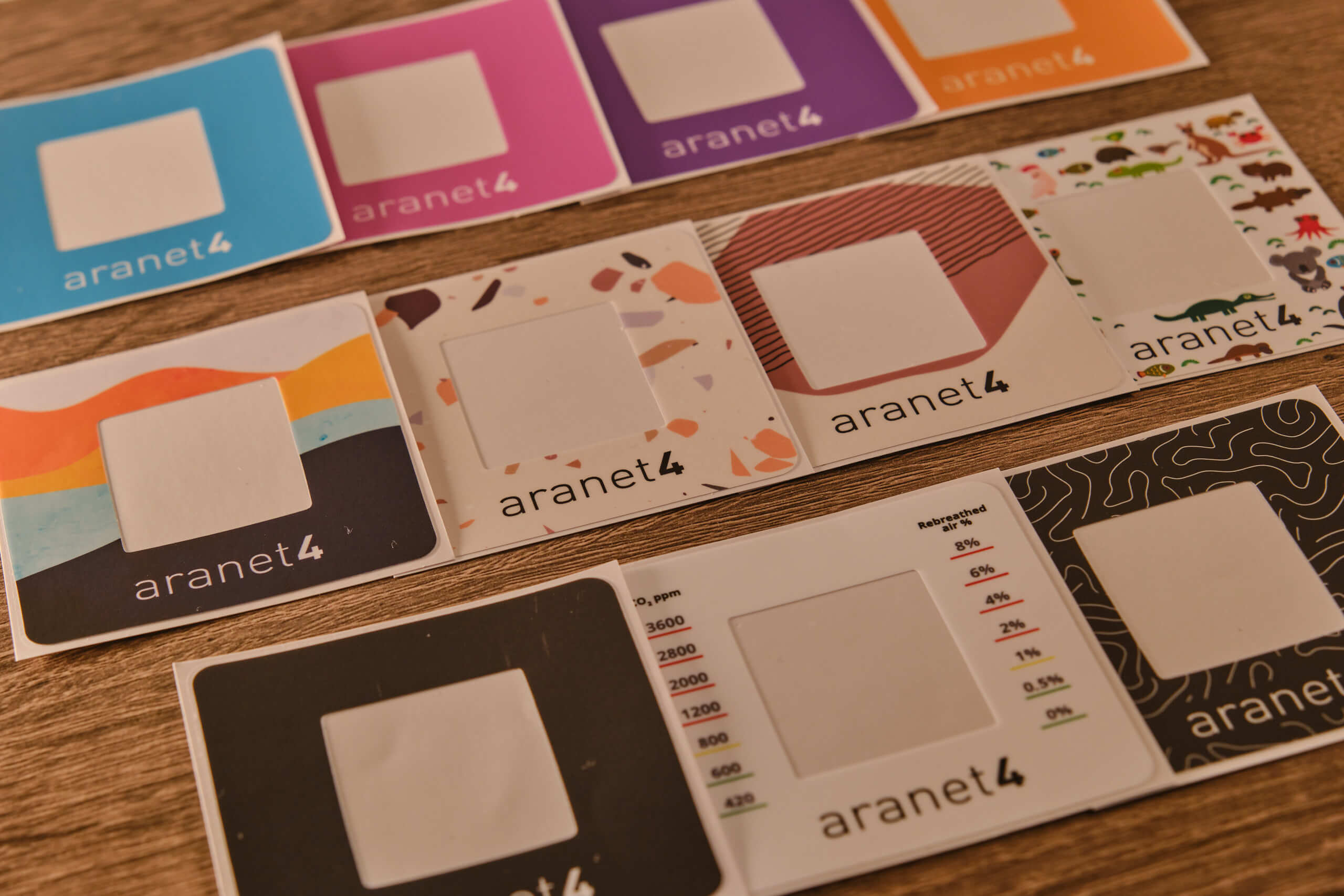
One interesting, albeit not very important, aspect of the Aranet4 Home is the customisation that SAF Tehnika has added to its device since its launch. While the Aranet4 Home has had great community support for a few years (with many users creating their own customisation stickers), the Aranet team has recently launched their collection of customisation stickers for the device.
Currently, three types of stickers are available – single-colour stickers that turn your device from semi-transparent to colours like purple or brown, design stickers featuring things like animals, and technical stickers such as the rebreathed air sticker. All of these have their place and can enhance the Aranet4.
While they may seem silly (I thought so at first!) I have come to appreciate some of the cute stickers, such as the animal sticker. With many parents sending their children to school with an Aranet4, these stickers can make the device seem much more friendly and less industrial. I can only imagine that other children would want to know what the device is if they saw it, and the cute stickers make it much more approachable.
The most useful sticker for most users, however, will be the rebreathed air percentage sticker. This useful little sticker shows the percentage of rebreathed air at different CO2 concentrations. This is useful for introducing and explaining the device to interested third parties. Using this sticker to explain the device, I’ve had a much warmer reception when I talk to people about it.
While it’s a minor factor, adding stickers to the Aranet4 store is nice to see. You can purchase a five-pack for $5, and while you will only need one per device, having extras means it’s okay if you make a mistake when placing a sticker on the device (which I have done… A couple of times!).
Is Aranet4 Home Worth it?
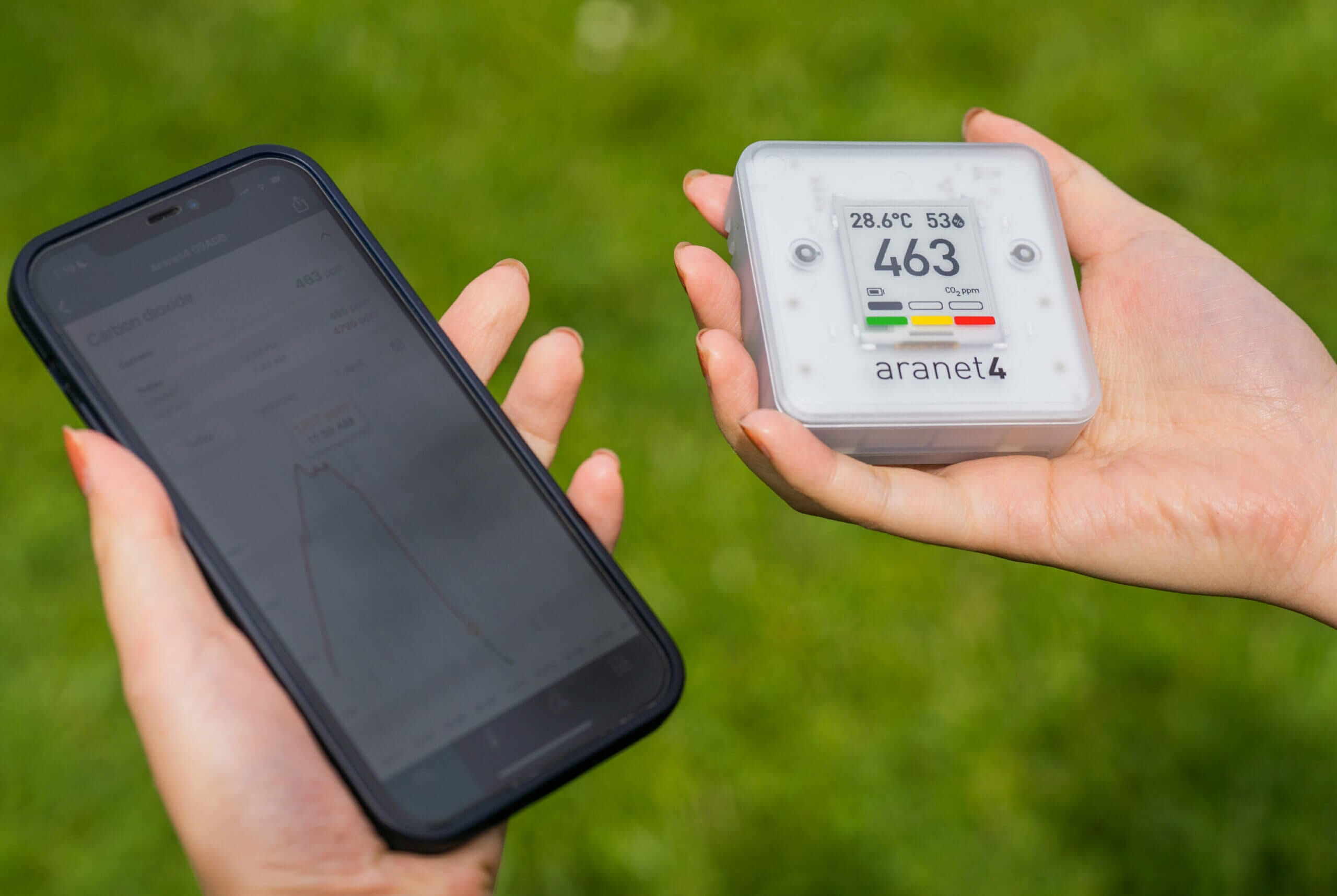
If you were to ask me whether or not I recommend the Aranet4 Home, my answer would be yes. This is a very precise carbon dioxide monitor that easily fits in your pocket, bag, or even alongside your computer on a desk. It’s straightforward to use but still provides the essential settings and allows manual calibration.
The only aspect that makes me hesitate when recommending the Aranet4 Home is the price. It’s far from cheap, and more affordable monitors are on the market. If the cost of the Aranet4 Home is too high for you to justify, it would be better to pick up one of the competing monitors instead.
However, some people will be okay with paying the premium. The built quality of the device is excellent, even if the whole product is plastic. The accuracy is best in class, the battery life is fantastic, and the app worked flawlessly throughout my time with the device.
Despite the price tag, this combination of factors allows me to recommend the Aranet4 Home. It offers a complete experience and worked flawlessly throughout my time using it. While there are a few minor changes I would like to see, these are to fine-tune an already great experience.
My biggest wish for the device is to see more protection added. Currently, it’s not water resistant, and it doesn’t have any drop resistance. While I understand air must enter the device, I’m sure there is some way to make the device at least somewhat water-resistant. In addition, some extra drop protection would also be fantastic.
Do you have any thoughts or experiences with Aranet4? If so, please feel free to share in the comments below! Alternatively, if you have any questions about the device, please ask, and I will do my best to answer. Thanks for reading!
Aranet4 Home FAQ
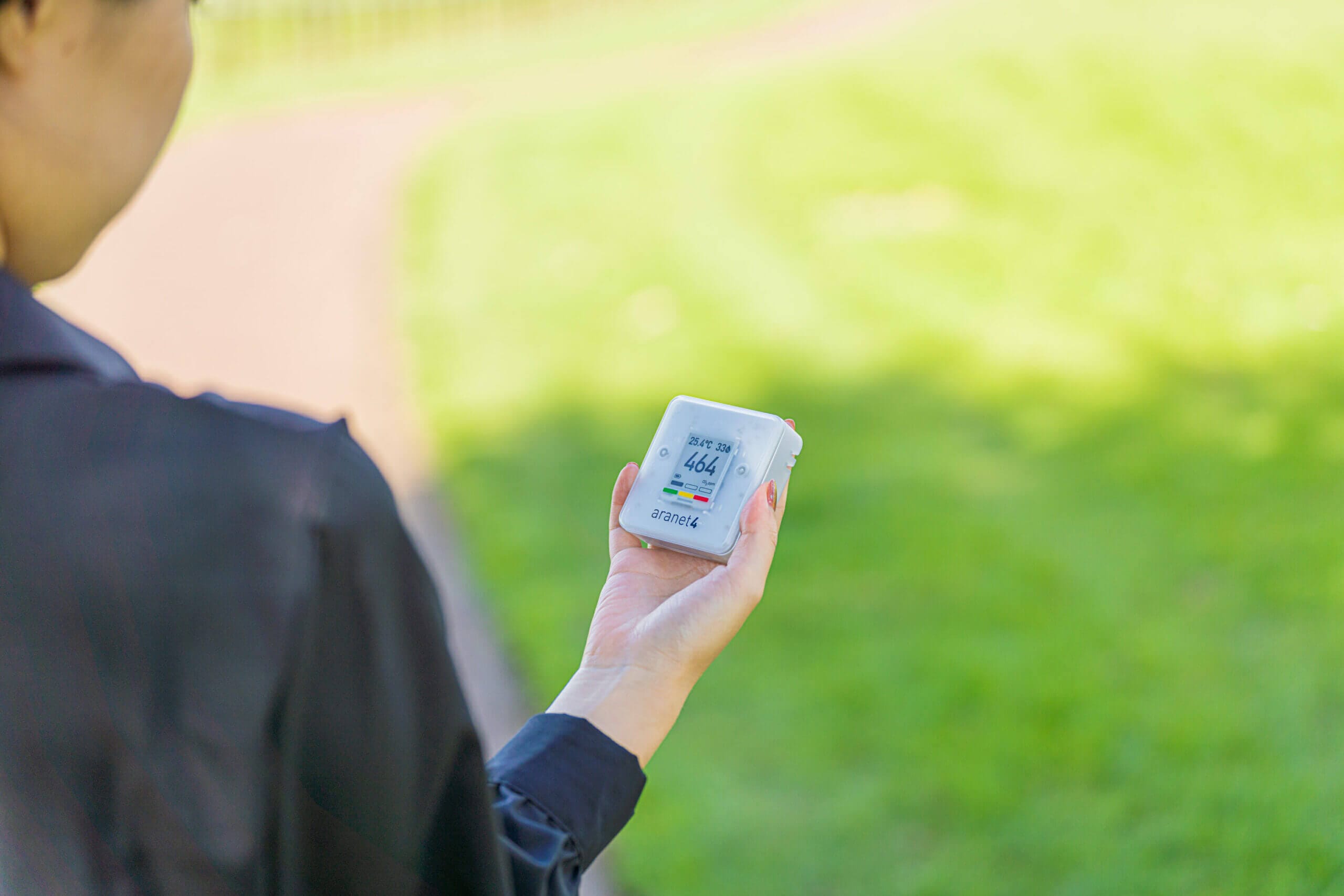
What Is the Difference Between the Aranet4 Home and Aranet4 PRO?
Both devices are physically the same and offer the same capabilities. However, the differences come in the form of connectivity. The Aranet4 Home is designed as a standalone device, whereas the Aranet4 PRO is designed to be used with multiple devices alongside an Aranet4 PRO Base Station.
How Accurate Is the Aranet4 Home?
The Aranet4 home is accurate within 30 ppm.
Where Can I Buy the Aranet4 Home?
You can purchase the Aranet4 Home from Aranet’s Amazon store. You can also purchase it from Aranet’s E-store.
What Does the Aranet4 Home Monitor?
The Aranet4 Home monitors carbon dioxide concentration, temperature, humidity, and atmospheric pressure.
What Alternatives Are There to the Aranet4 Home?
The most popular alternatives are Qingping air quality monitors. However, these tend to be less accurate.
Have Questions or Comments?
Join the discussion on the BreatheSafeAir Community Forum. Ask any questions you have about air quality or adjacent topics and get quick answers!
Aranet4 Home
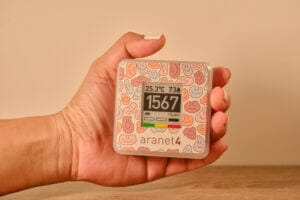
The Aranet4 Home and Aranet4 PRO are two of the most popular carbon dioxide monitors currently available. With high accuracy and a straight-forward and easy-to-use design, these monitors have set the standard for portable carbon dioxide monitors.
Product Brand: Aranet
5
Pros
- Highly accurate
- Easy-to-use
- Pocketable & easily portable
- Great app experience
- Long battery life
- Customisable readout times
- Good build quality
- Receives updates with new features
- Most well-rounded CO2 monitor
Cons
- Expensive (even with discounts)
- Somewhat fragile
- Some sensor drift
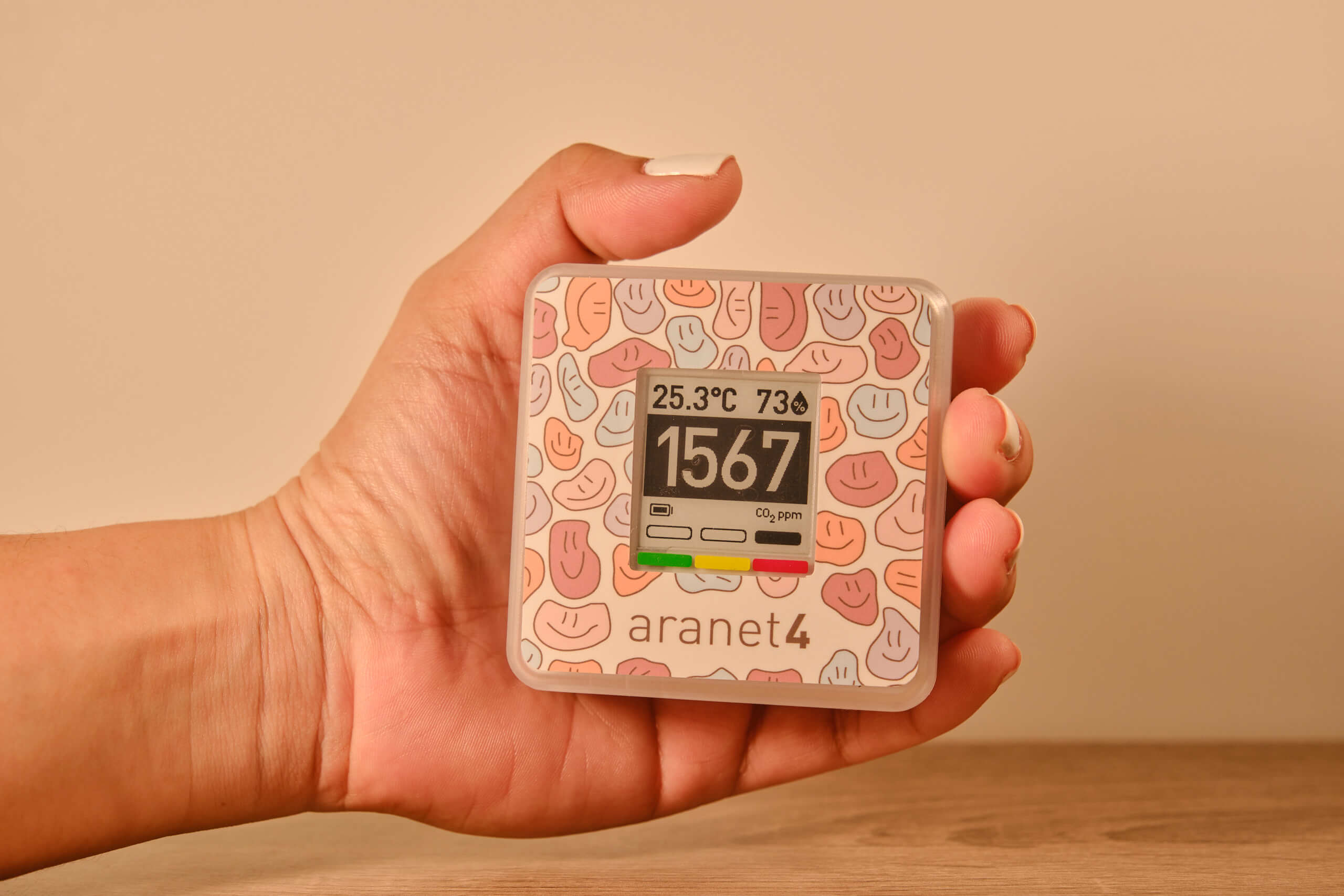
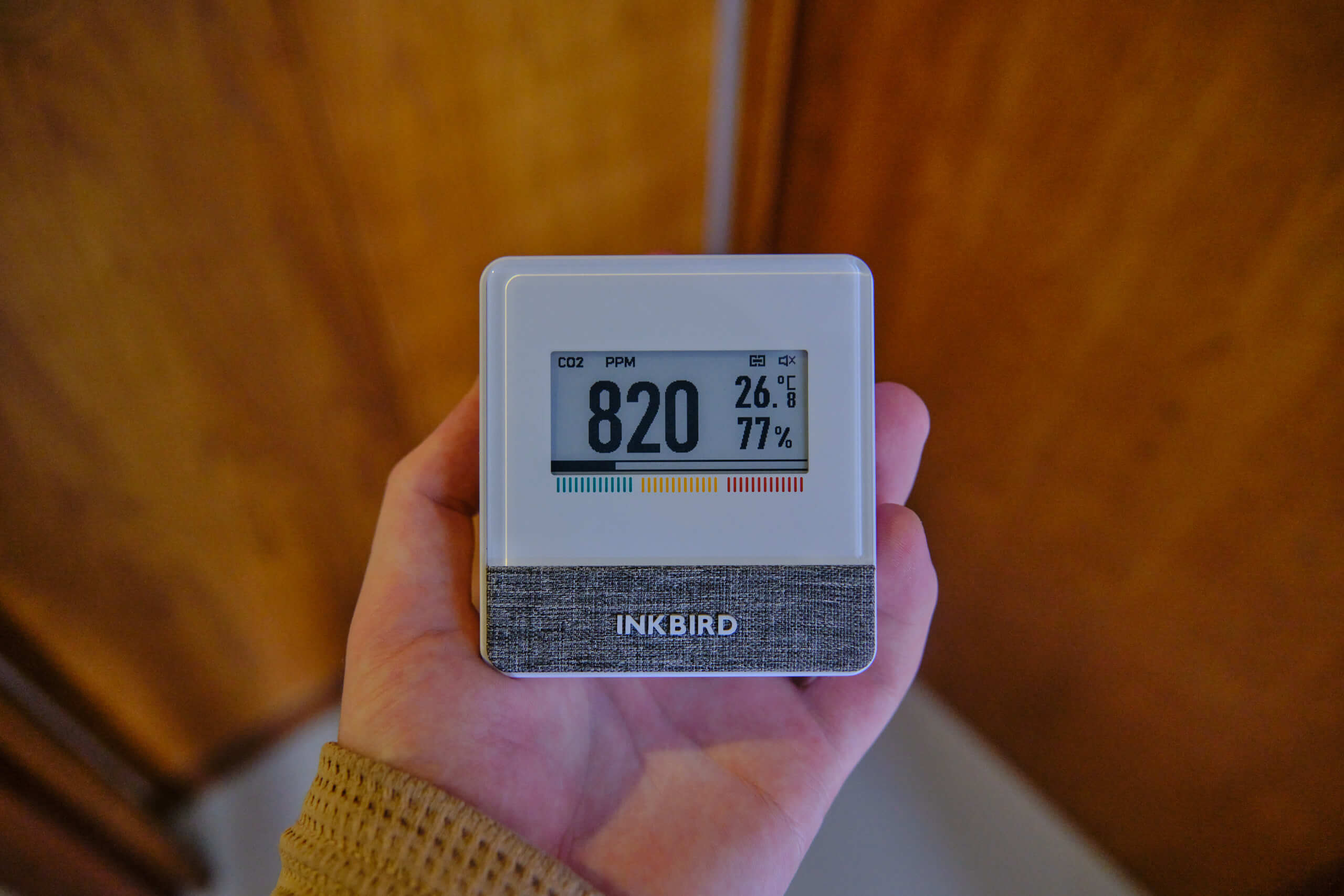
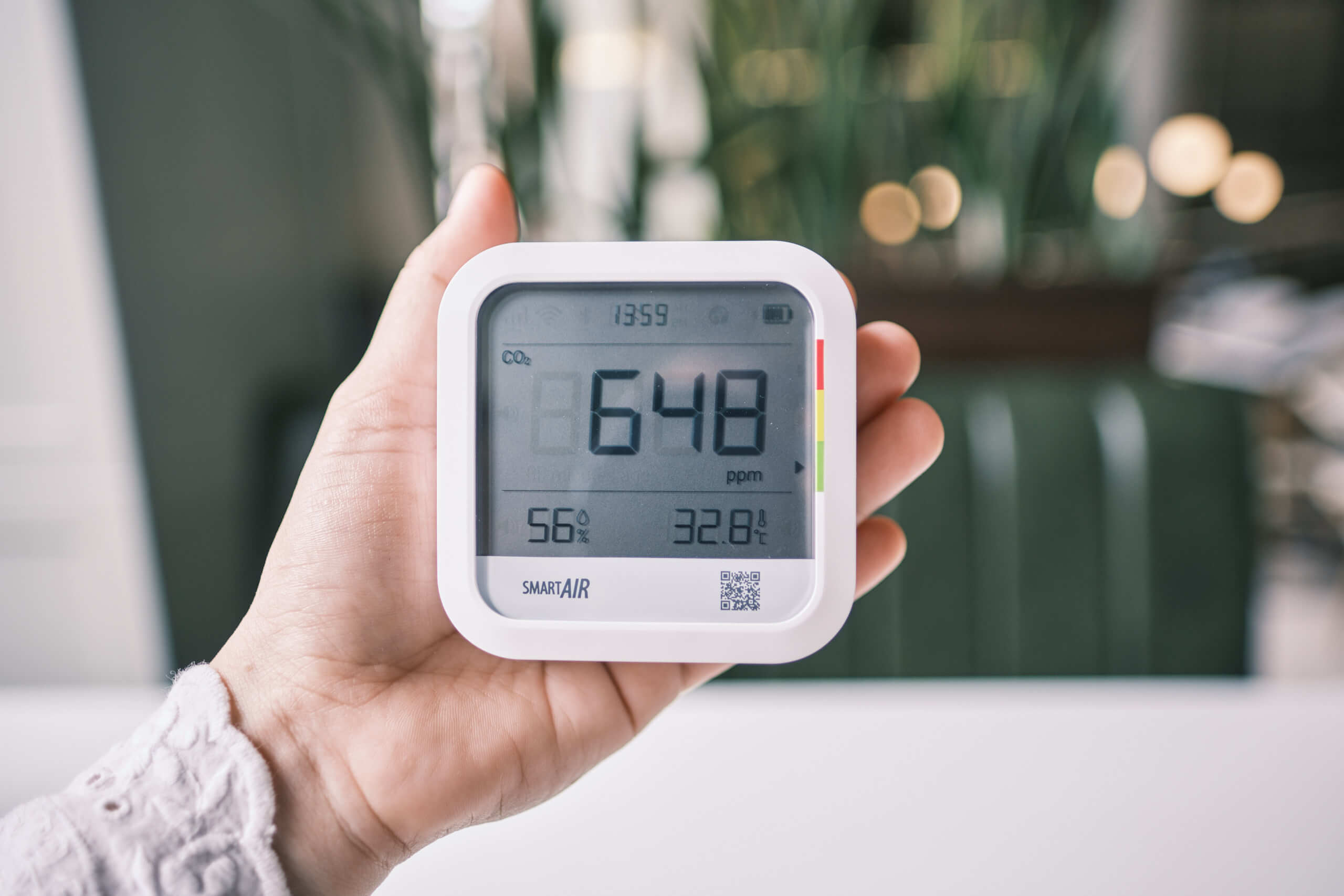
Hello, please note that in trality you CAN export data from the Aranet4 App, on an Excel file (csv format): just click on the button at top-right corner of the graphs-window and you will get your .csv file that you may share on WhatsApp, email, and so on.
The button is also visible on the App screenshots that you have posted above to show the graphs of CO2 from App.
Perhaps you may review the document accordingly? In such case, you may even cancel this comment…
By the way: congratulations for the review: very well done and your way of writing is so good to explain complex things: BRAVO!
Hi,
Firstly, thank you so much for the kind words! I appreciate it.
You are totally right regarding the exporting of data – I missed that as I didn’t expect it to be under the ‘share’ button! I’ve updated the article now. I am very happy to see this capability within the app!
I’ve used one for about 6 months now. Made me happy about my office and sad about my house. In terms of protection, I just leave it in the original packaging in my backpack and use the app to interrogate it – the amount of buffering does not appear to be significant, although does make it a little awkward in restaurants…
Hi Duncan,
Thanks for sharing your experience! By original packaging, do you mean the box?
Yes.
This was a thorough and excellent review. Thank you for spending the time on it!
You’re welcome! Thank you for the kind words 🙂
Also take a look at co2.click, a Canadian designed and made CO2 sensor solution. Connected (Model C), cloud portal with 48 months of data retention, dual-beam NDIR technology. Model D is local storage only. And lower cost than the Aranet4, the co2.click starts at 189$CAD (~138$USD).
Review by @jeffgilchrist here: https://twitter.com/jeffgilchrist/status/1528016215779713024
Thank you, I will!
Regarding the person that left the unit in the box to protect it, would it get adequate readings if it was packed up like that?
Also, how quickly does one get an accurate reading from the device?
Hi Nathan,
I’m not sure what the box looks like, but if it doesn’t cover the vents on the device, it should still function as normal.
Readings should be accurate out of the box as it is factory calibrated! If not, you can manually calibrate it and begin getting accurate readings within a few hours.
I wish it worked with Smart things / Z-wave / make.
I think that the accuracy data in your table is slightly incorrectly stated. I think the accuracy should be stated as +/- (30ppm + 3%), not “OR”.
Great review.
Hi Larry,
Looking back at the spec sheet, you may be right. I interpreted it as whichever was larger. I will check with Aranet and confirm!
Thank you for pointing this out.
Many thanks for this comprehensive and informative review.
I work as a secondary school teacher and use my Aranet4 every day to monitor and manage classroom air quality. If I was the Minister for Education there would be one installed in every classroom, staff room and office. Until then for any teacher interested in breathing clean air in their workplace, and protecting their students an Aranet4 is certainly worth the investment.
Although I wouldn’t drop the device on purpose, mine has had a bit of abuse from students making poor choices and is still operating well, maybe I’ve just been lucky, but it is quite robust.
The Aranet4 is an outstanding CO2 meter. Easy to use. Fantastic having the app so I can look back on the CO2 readings for any given time period. I highly recommend using an Aranet4 to alert you to indoor places which may have higher risk of COVID.